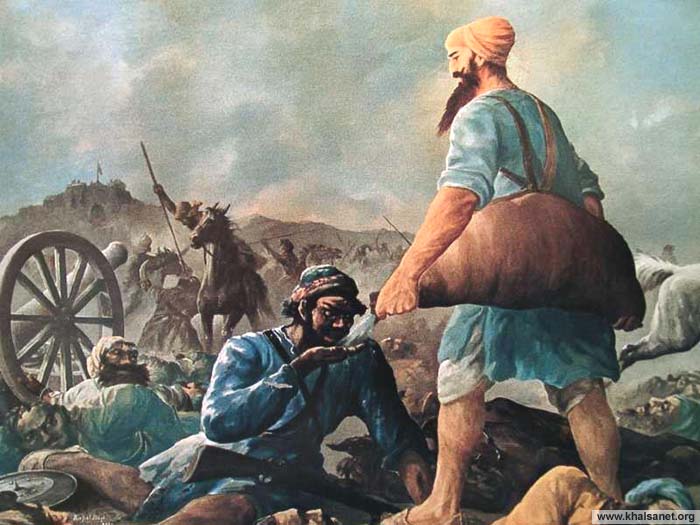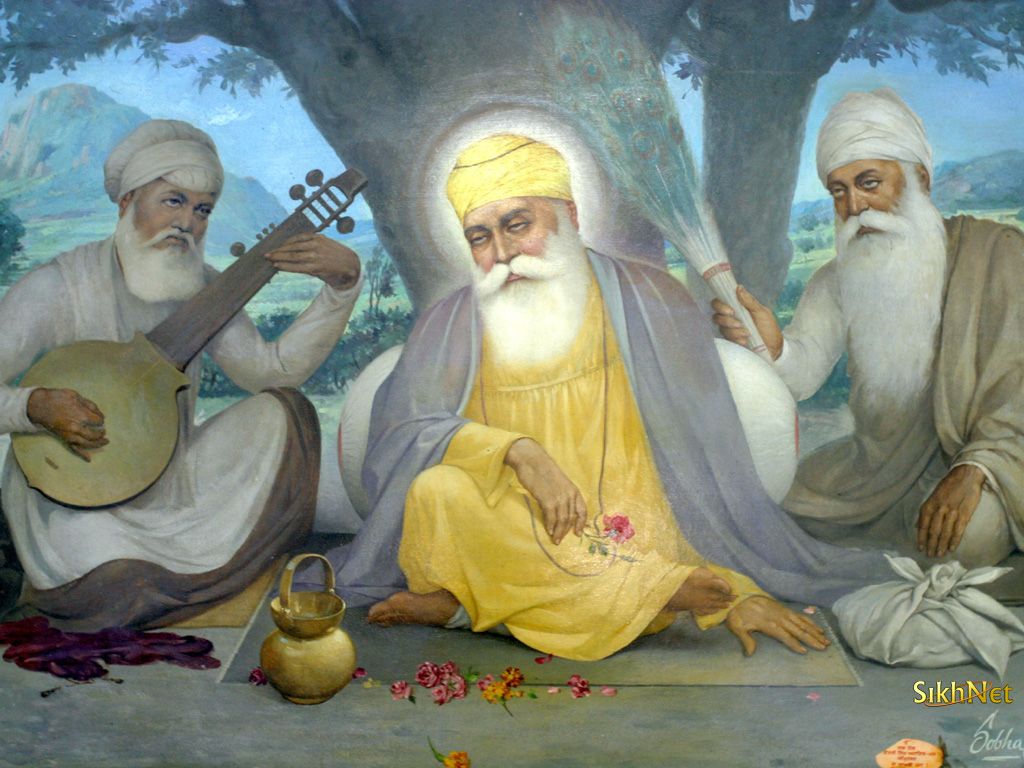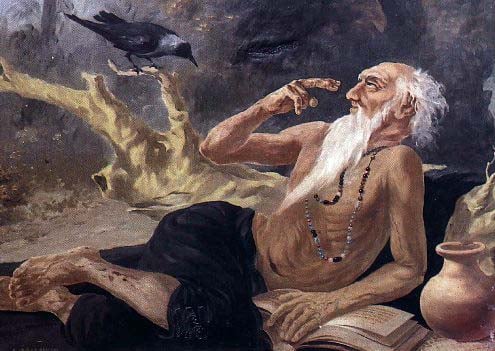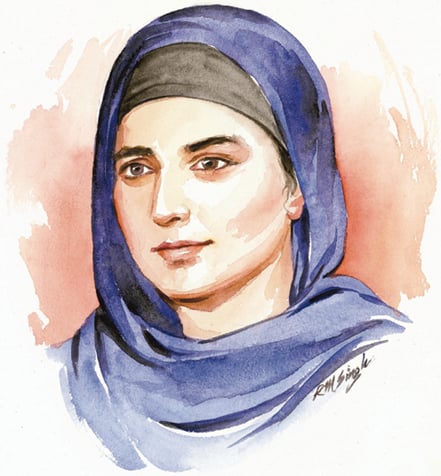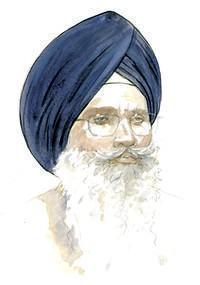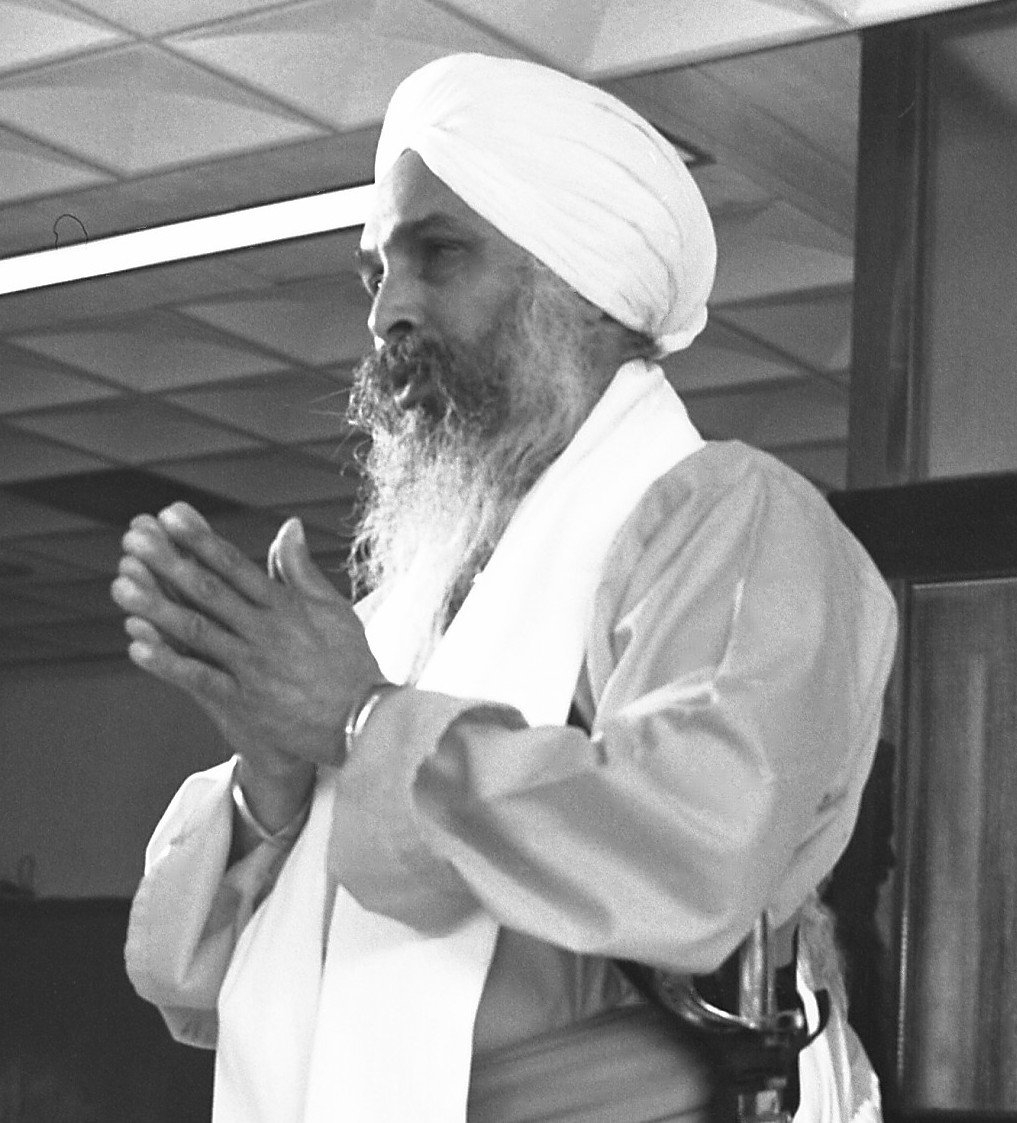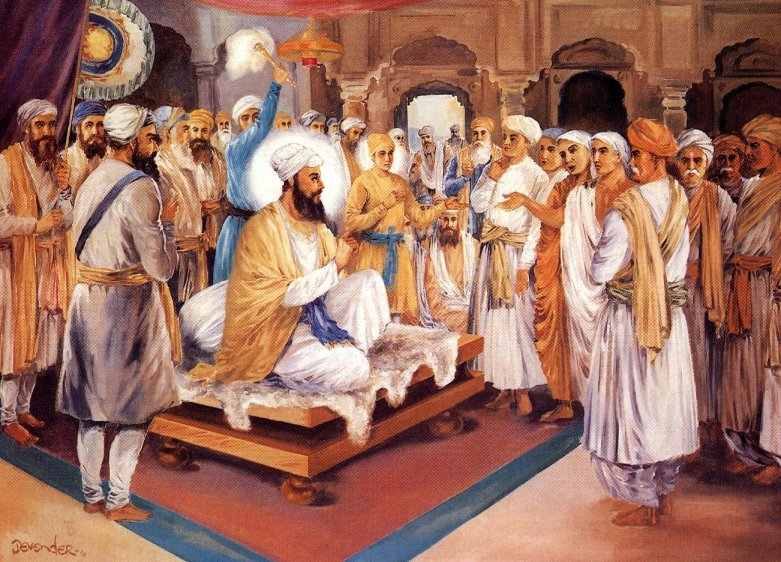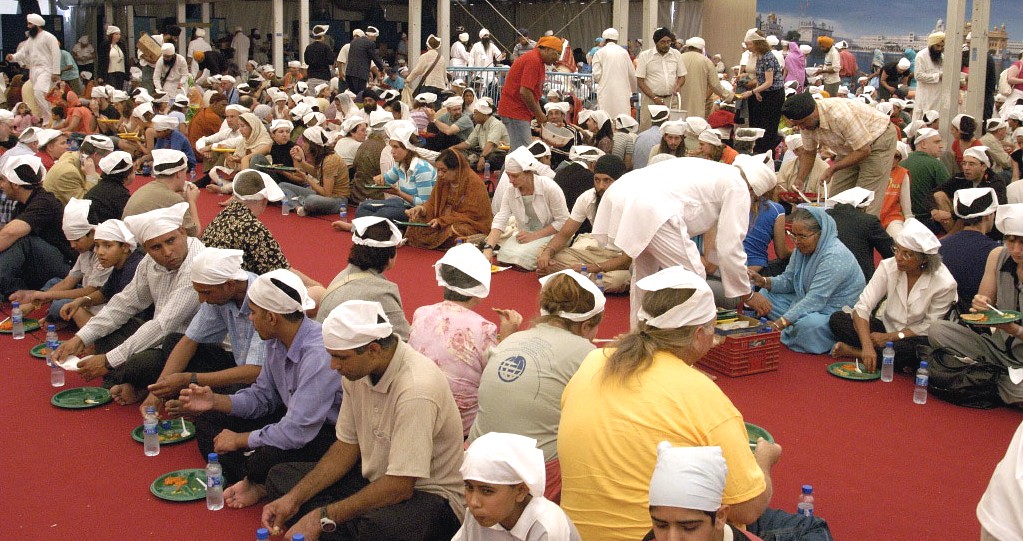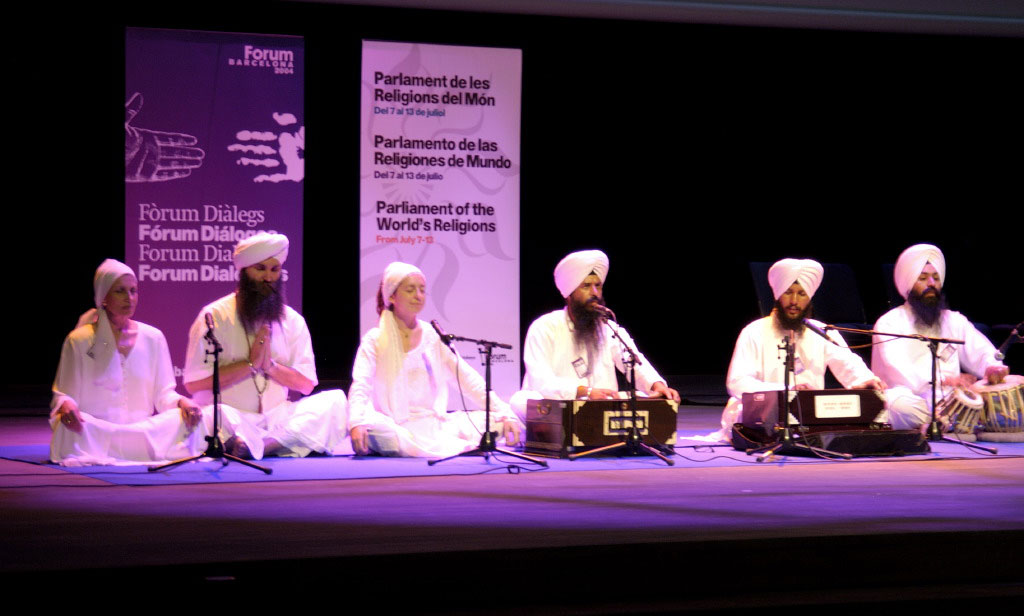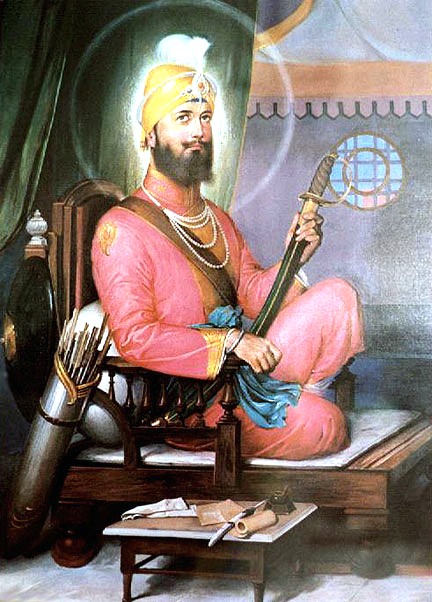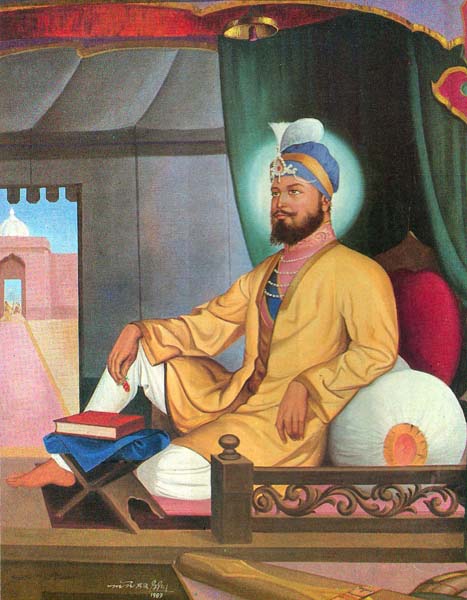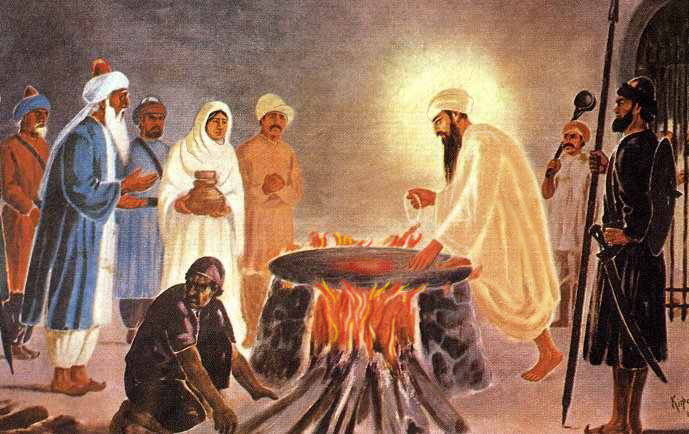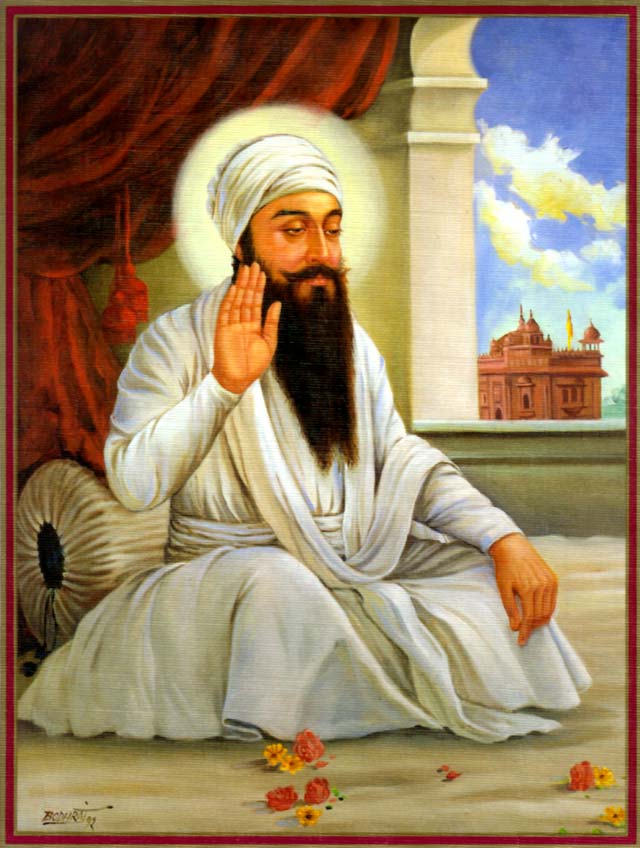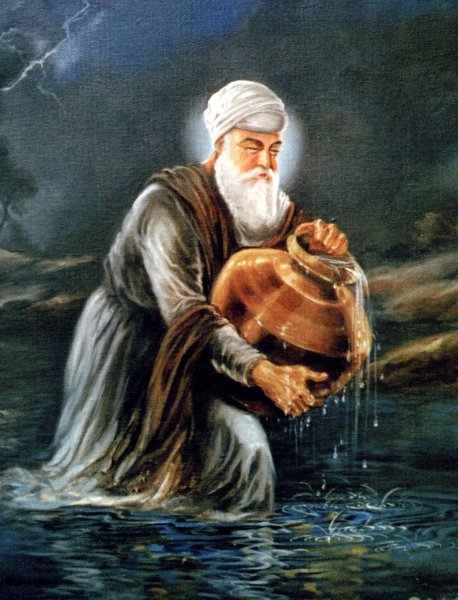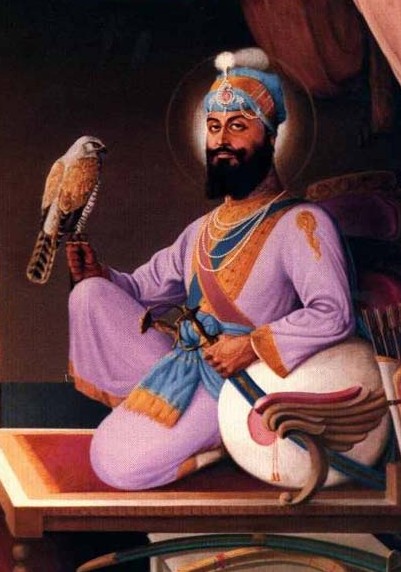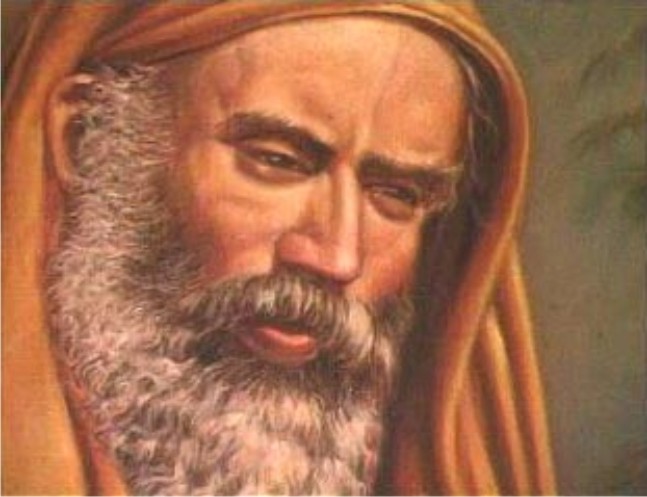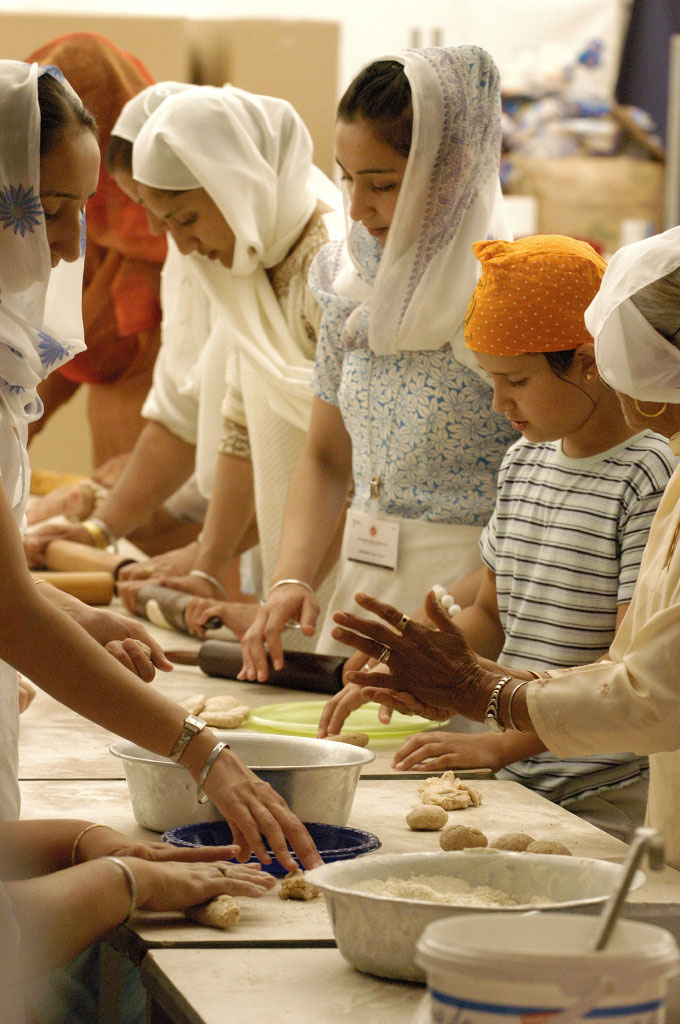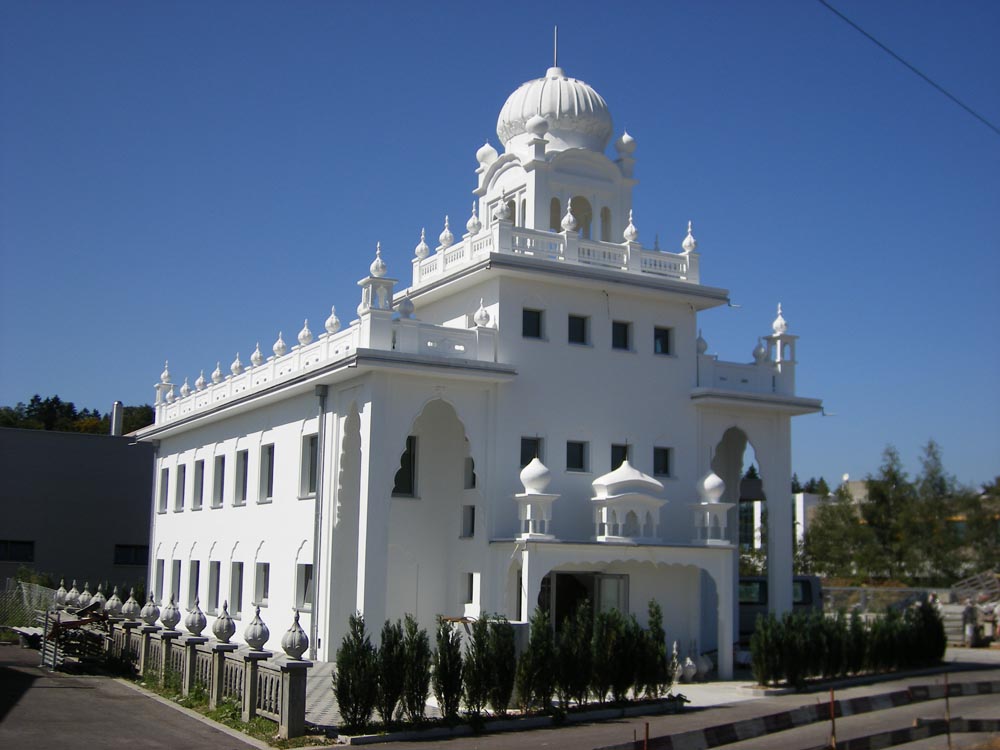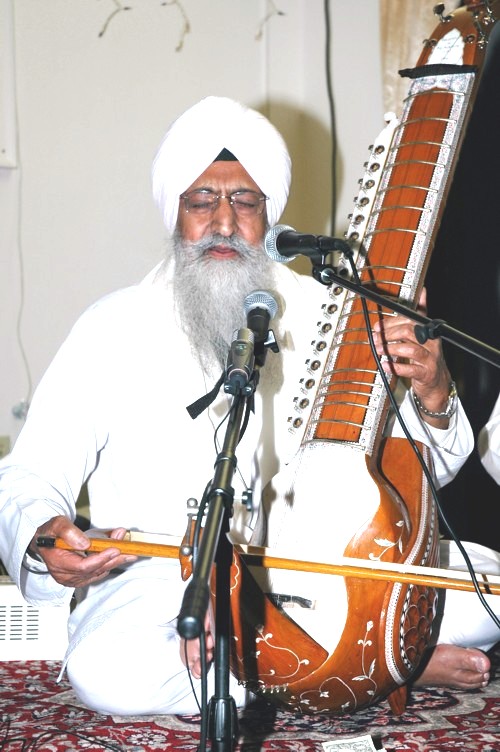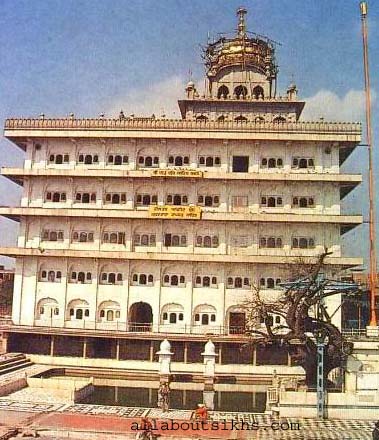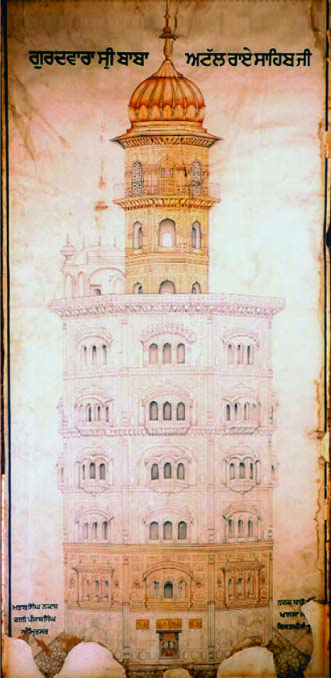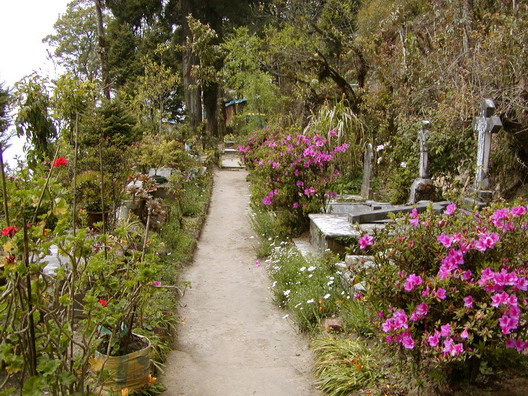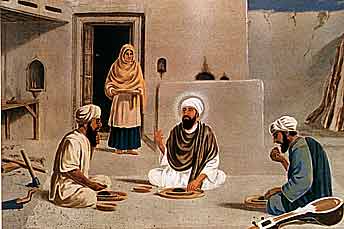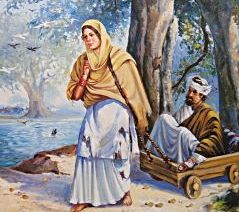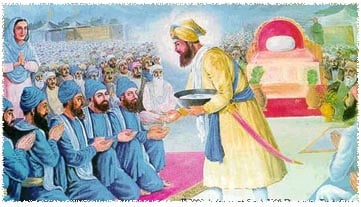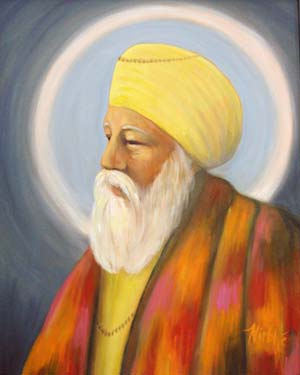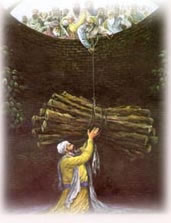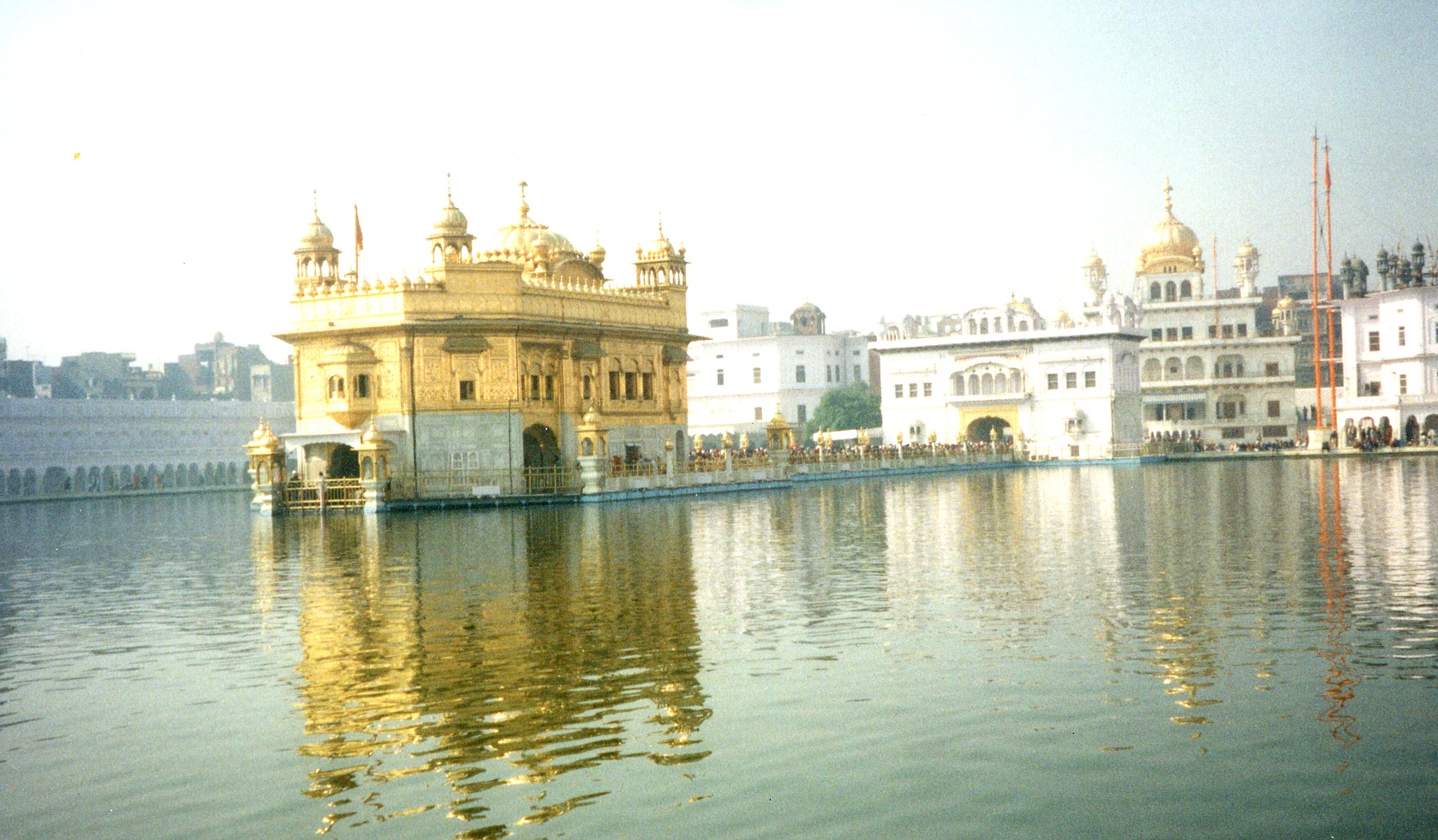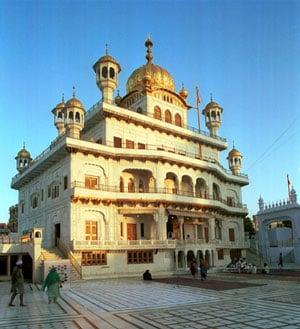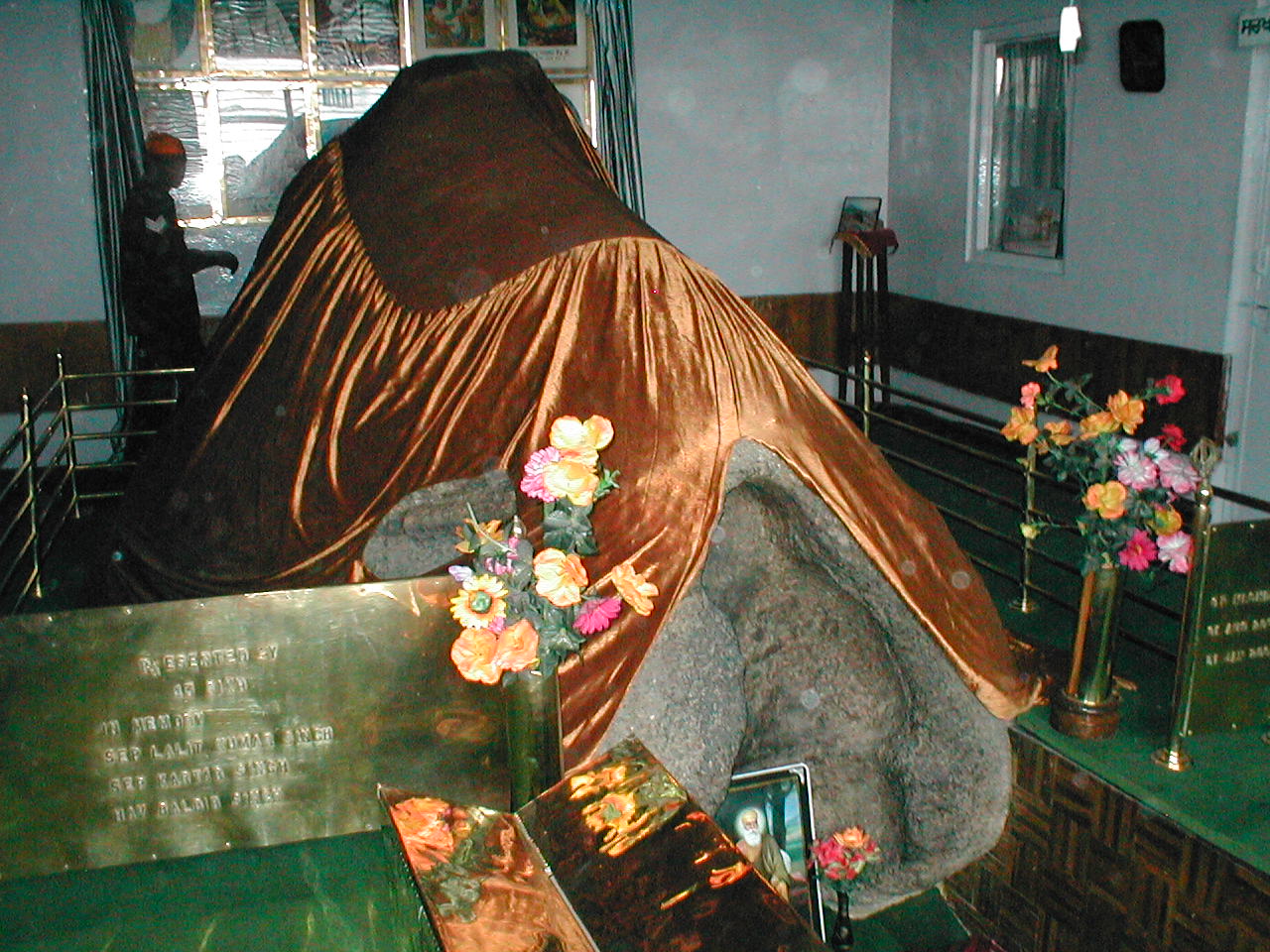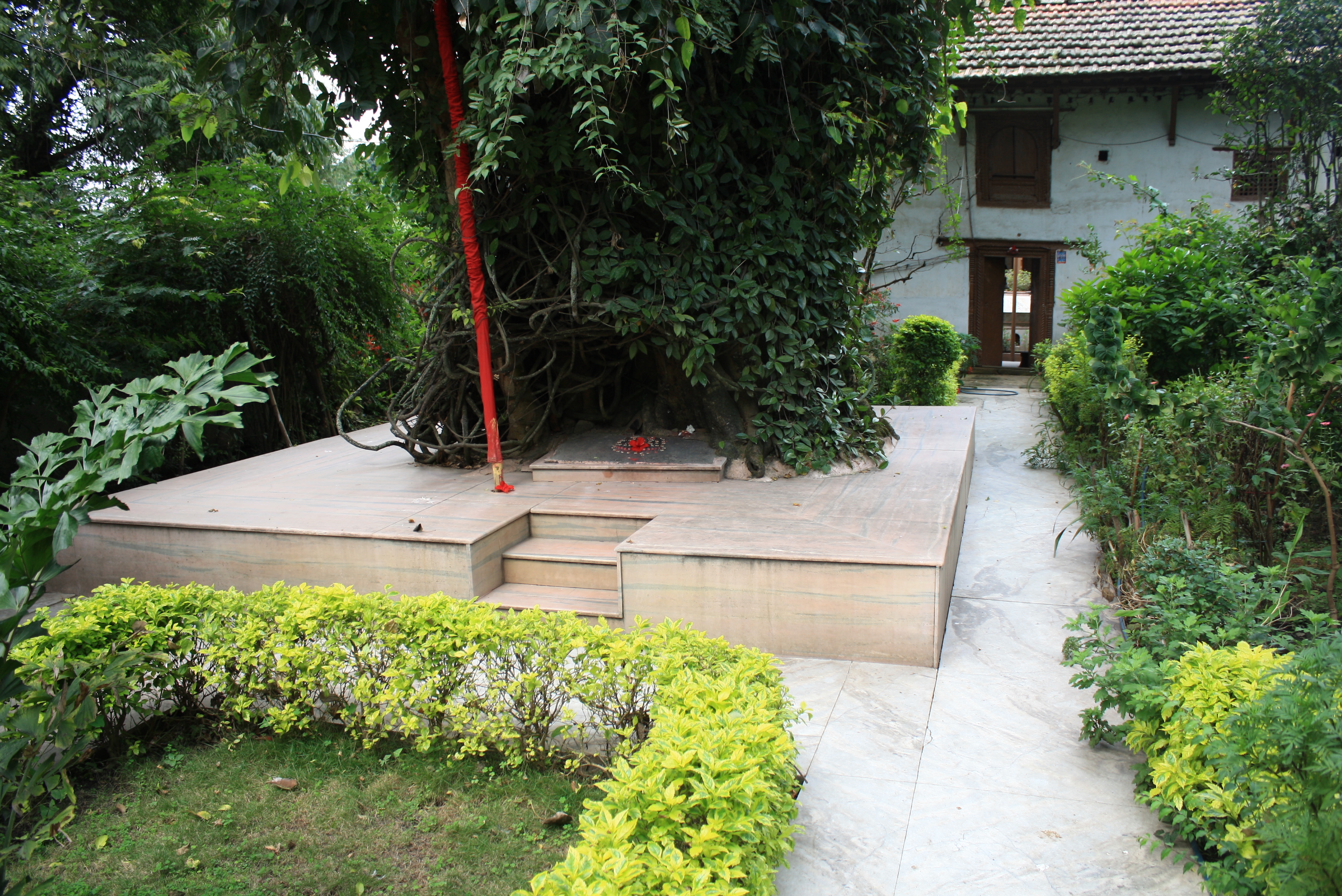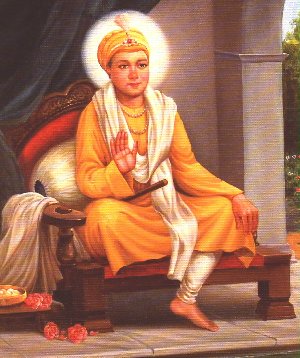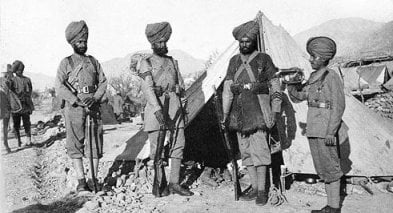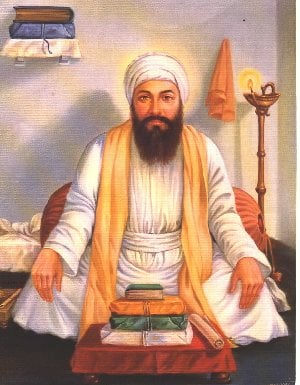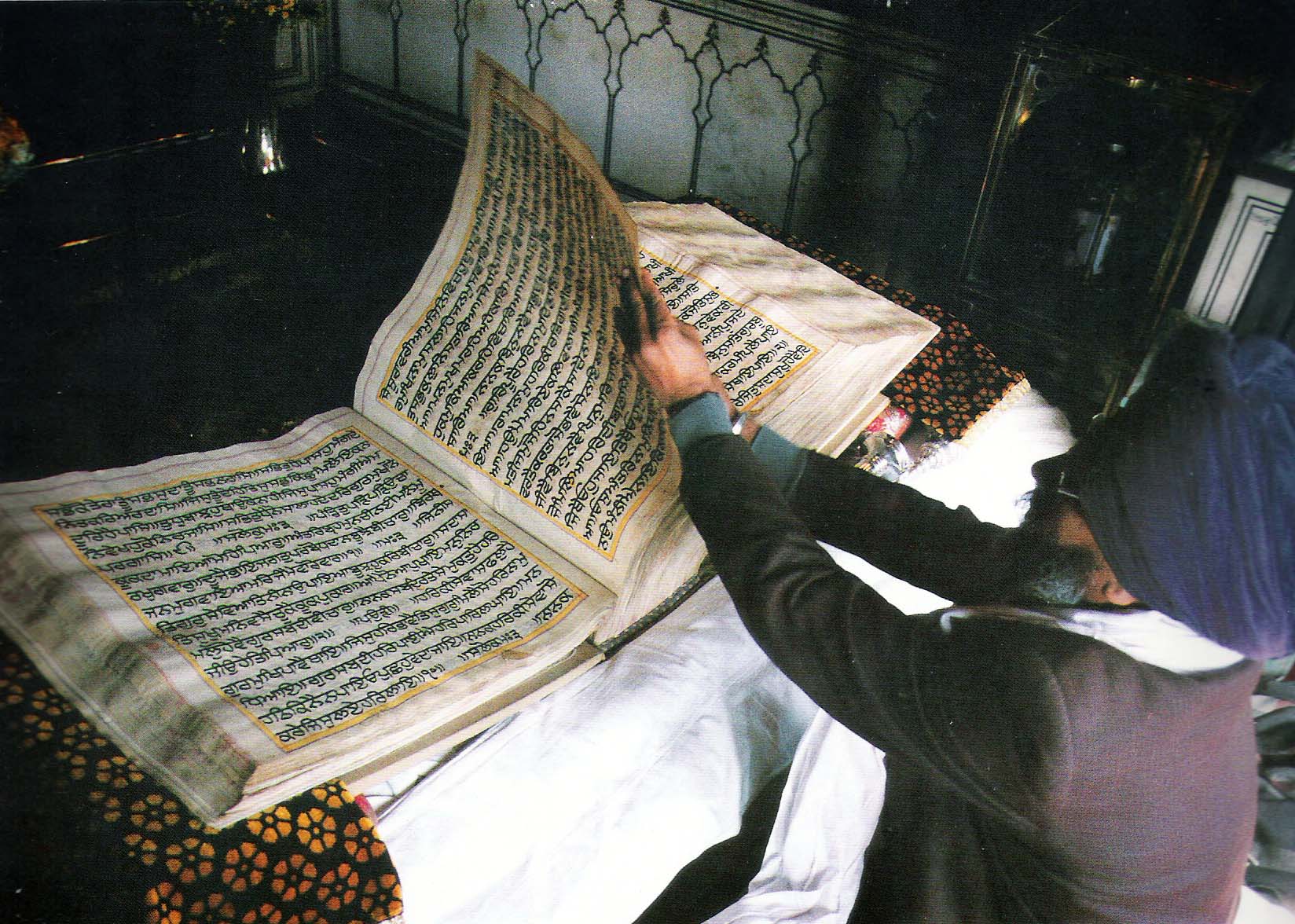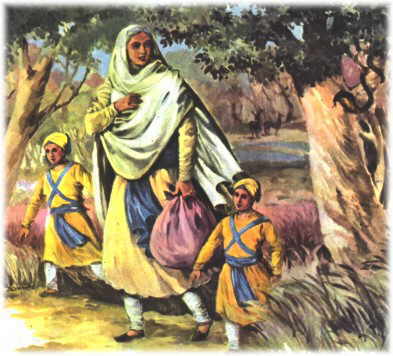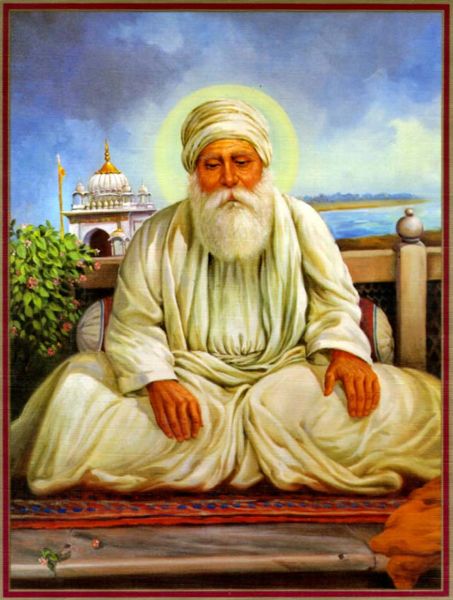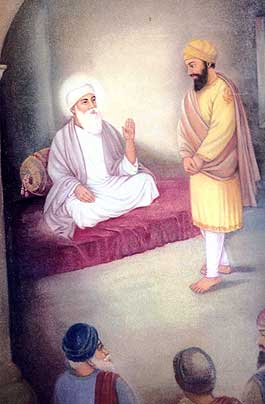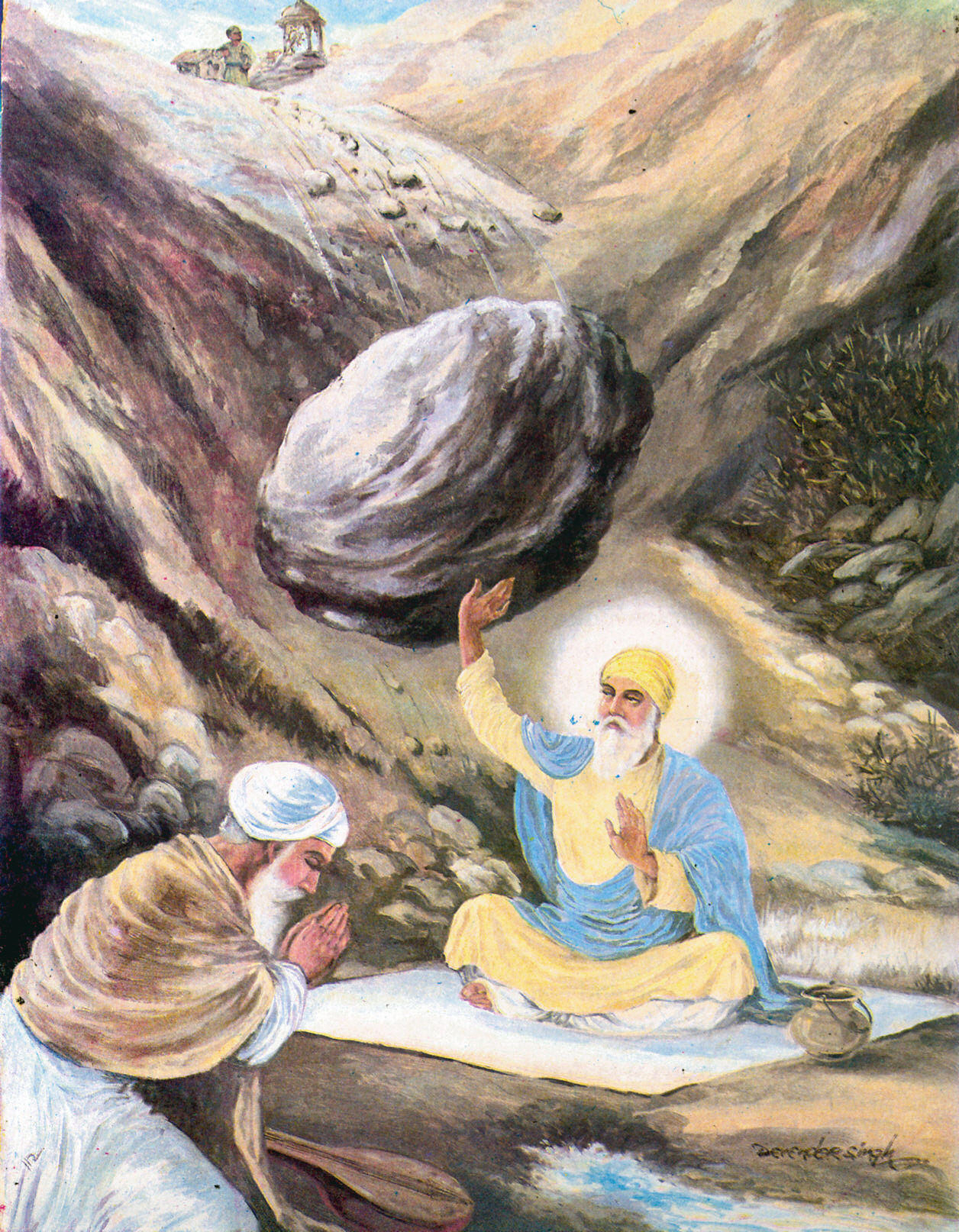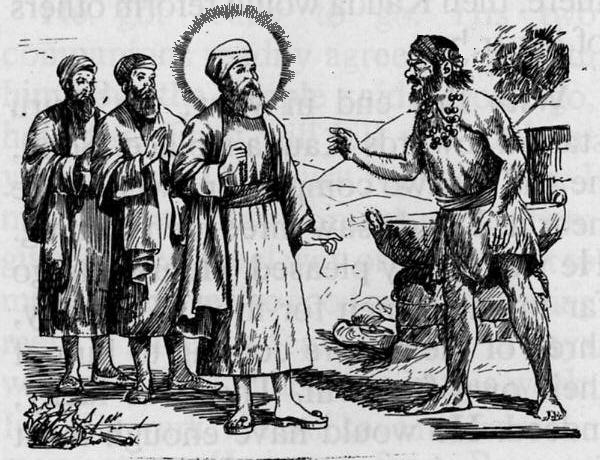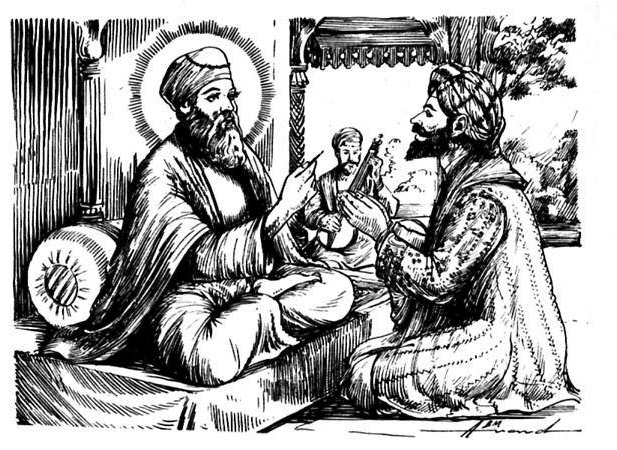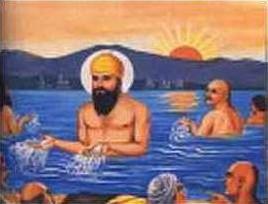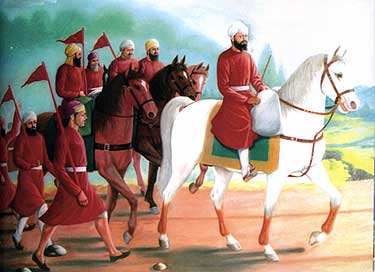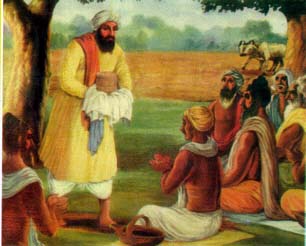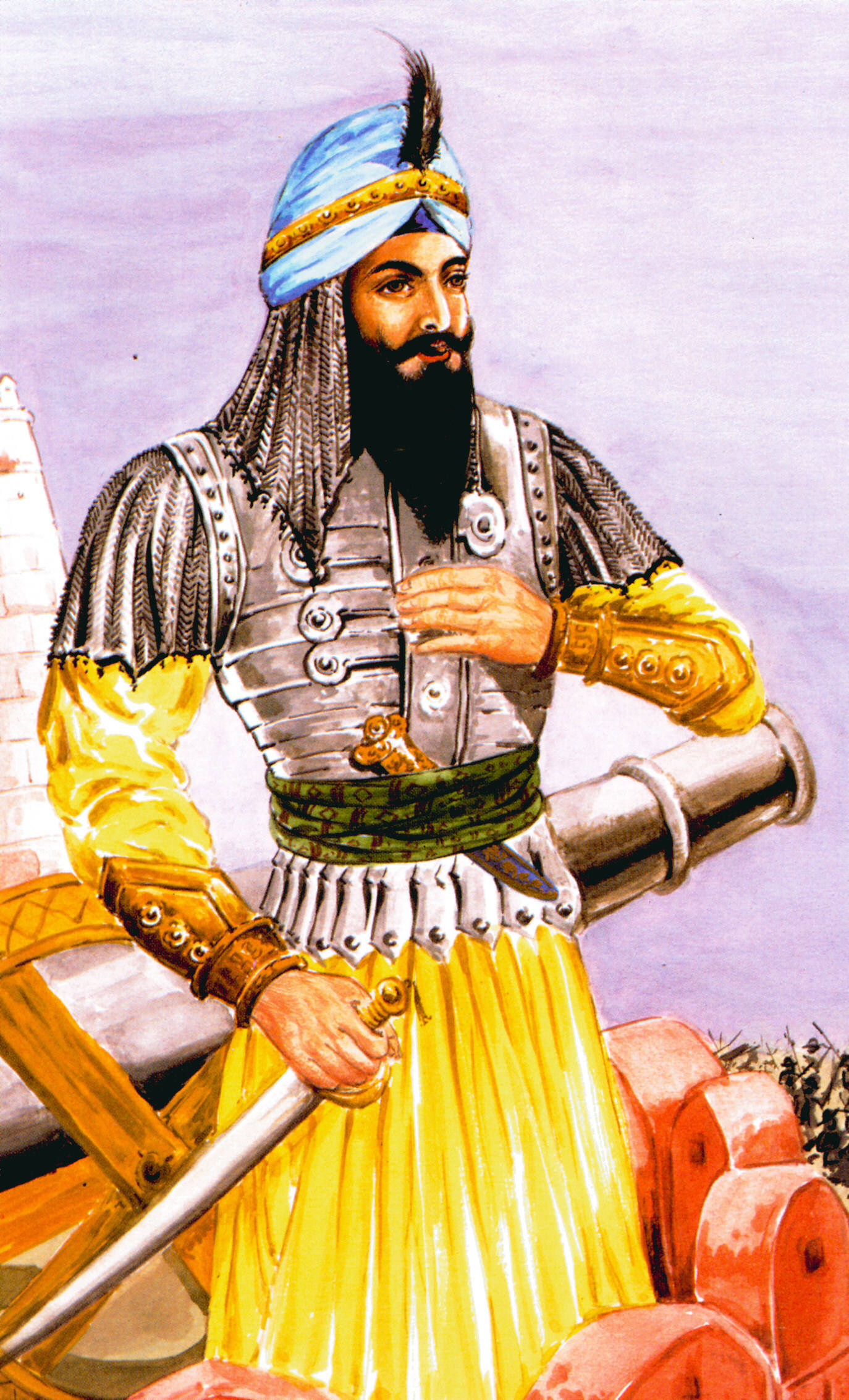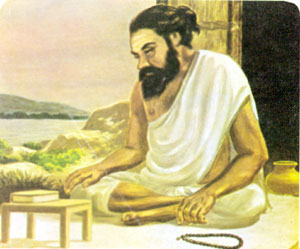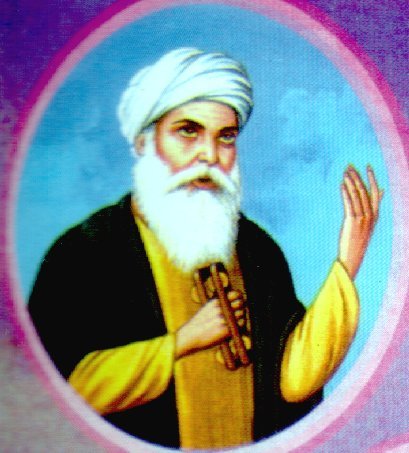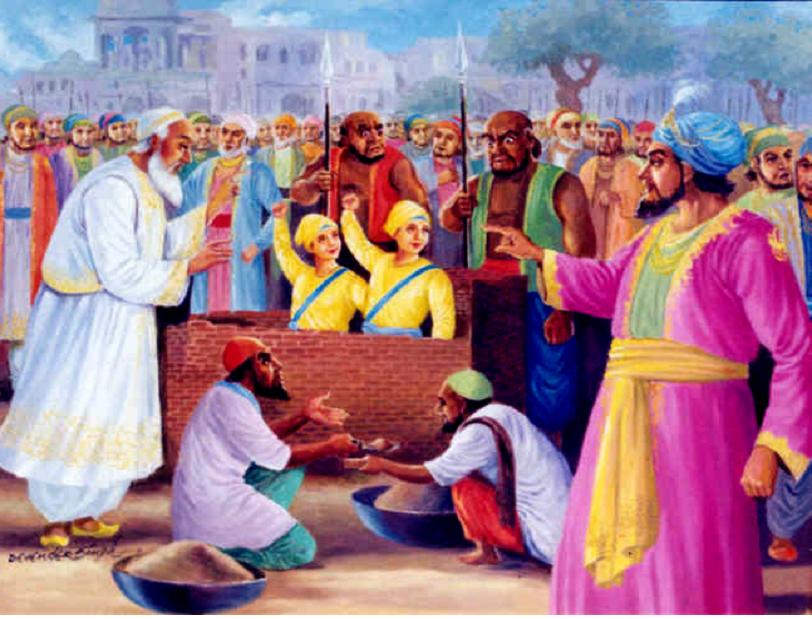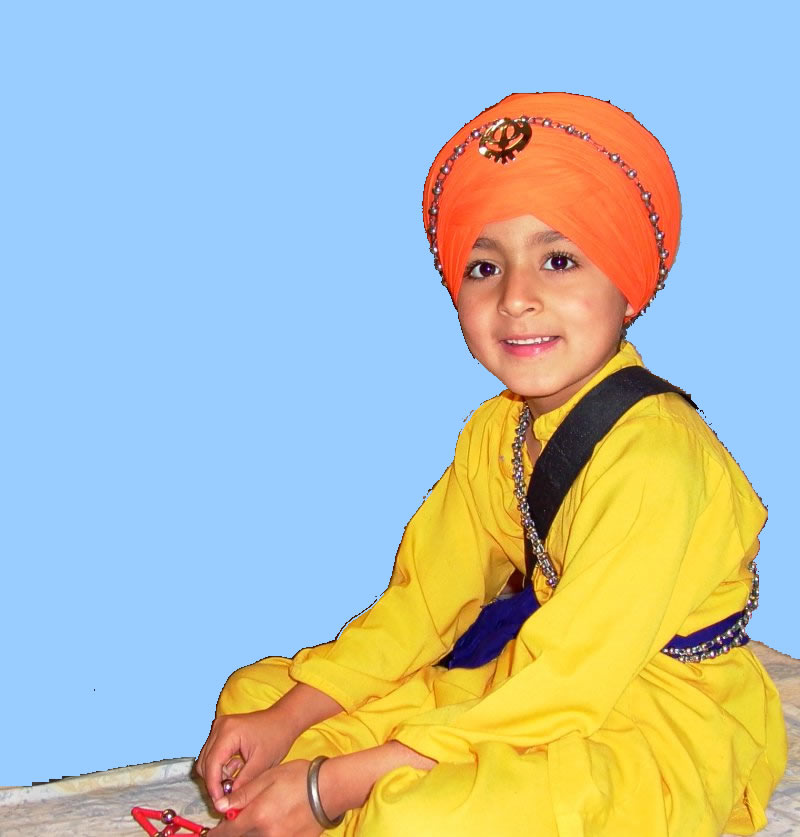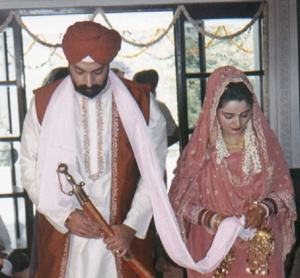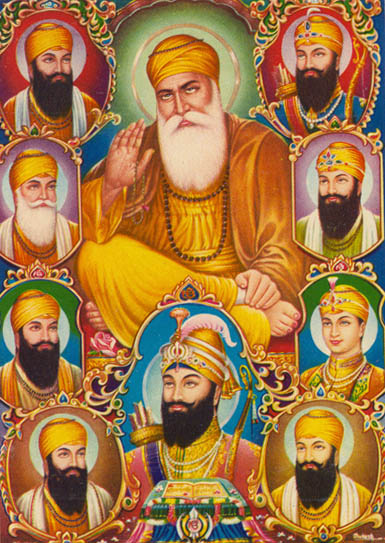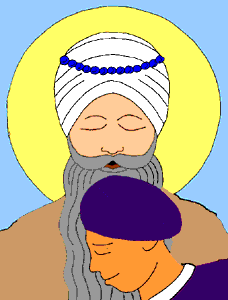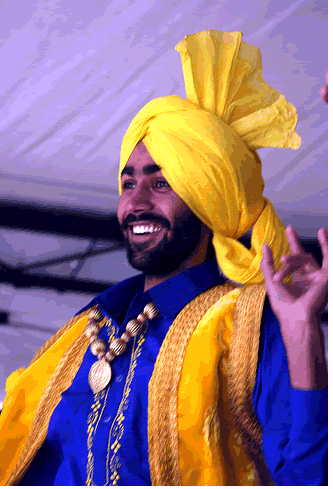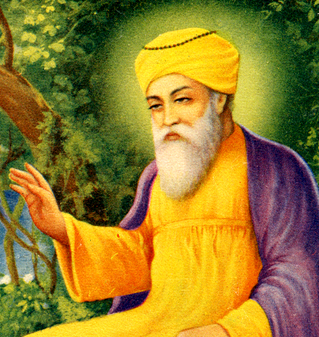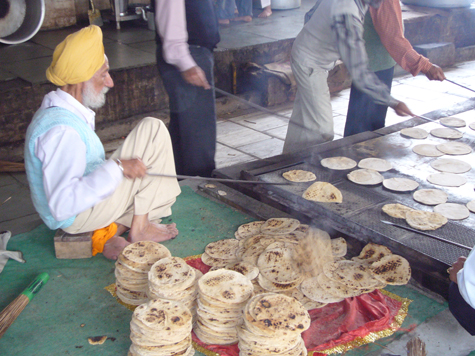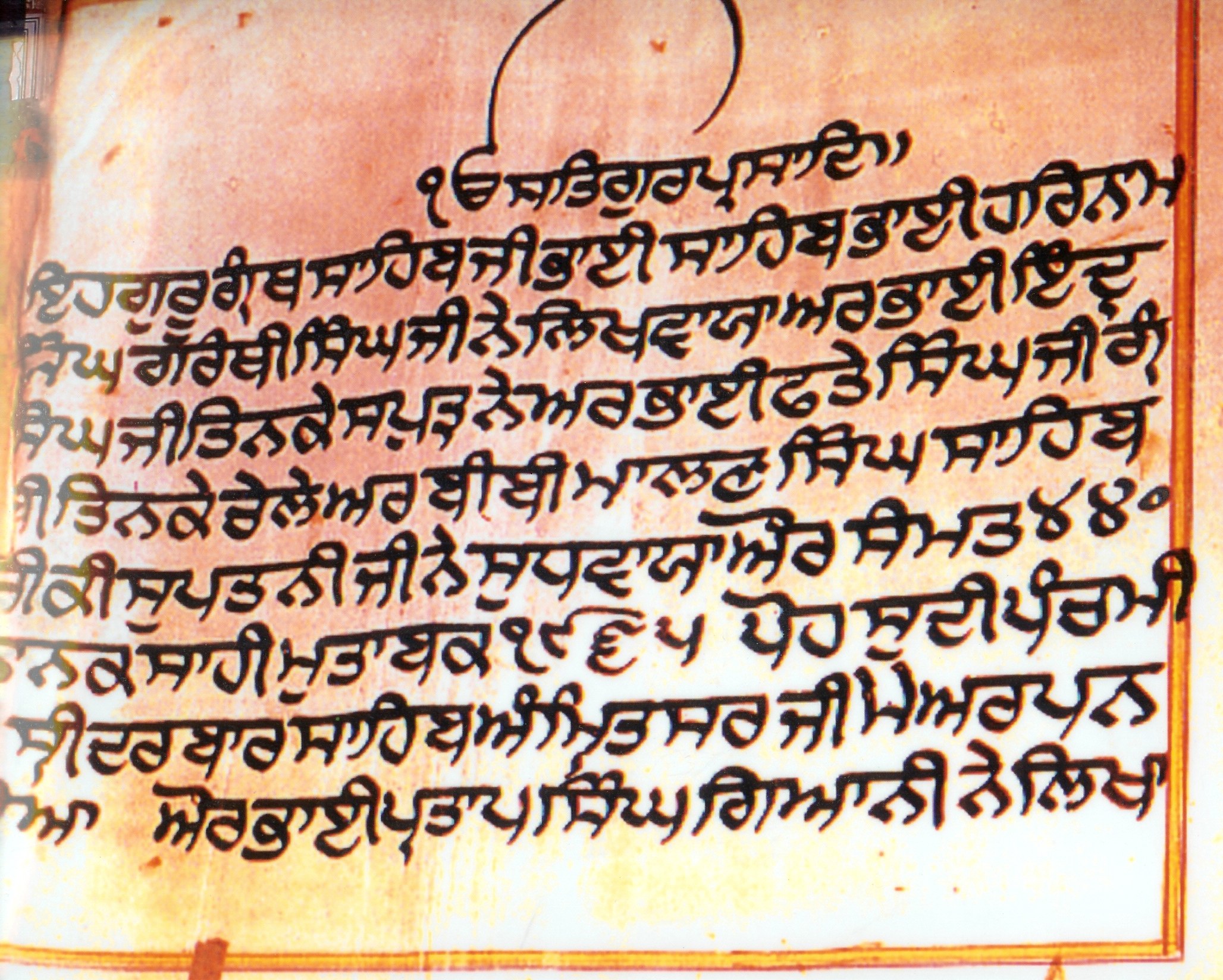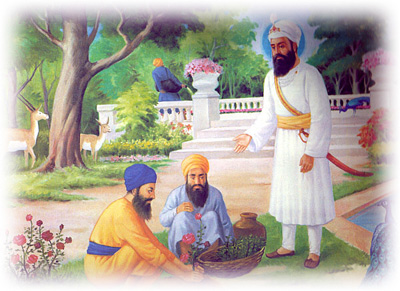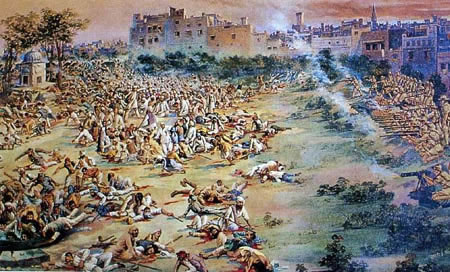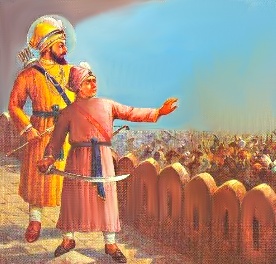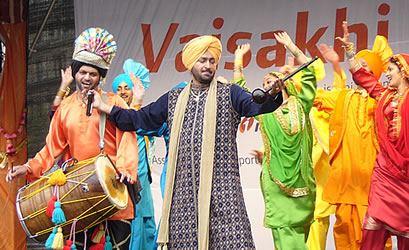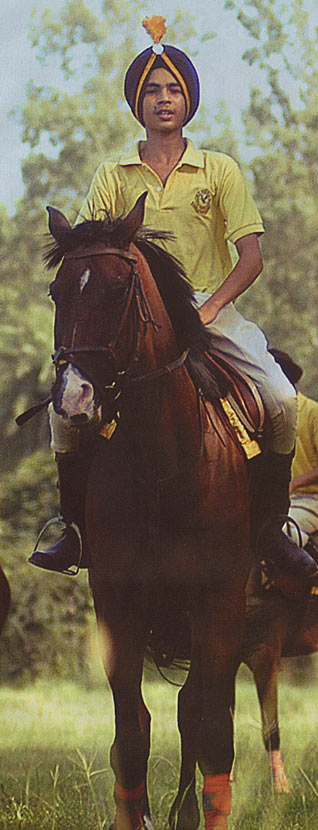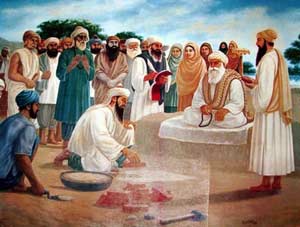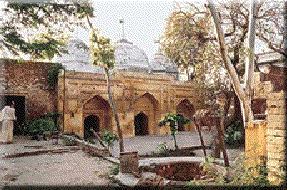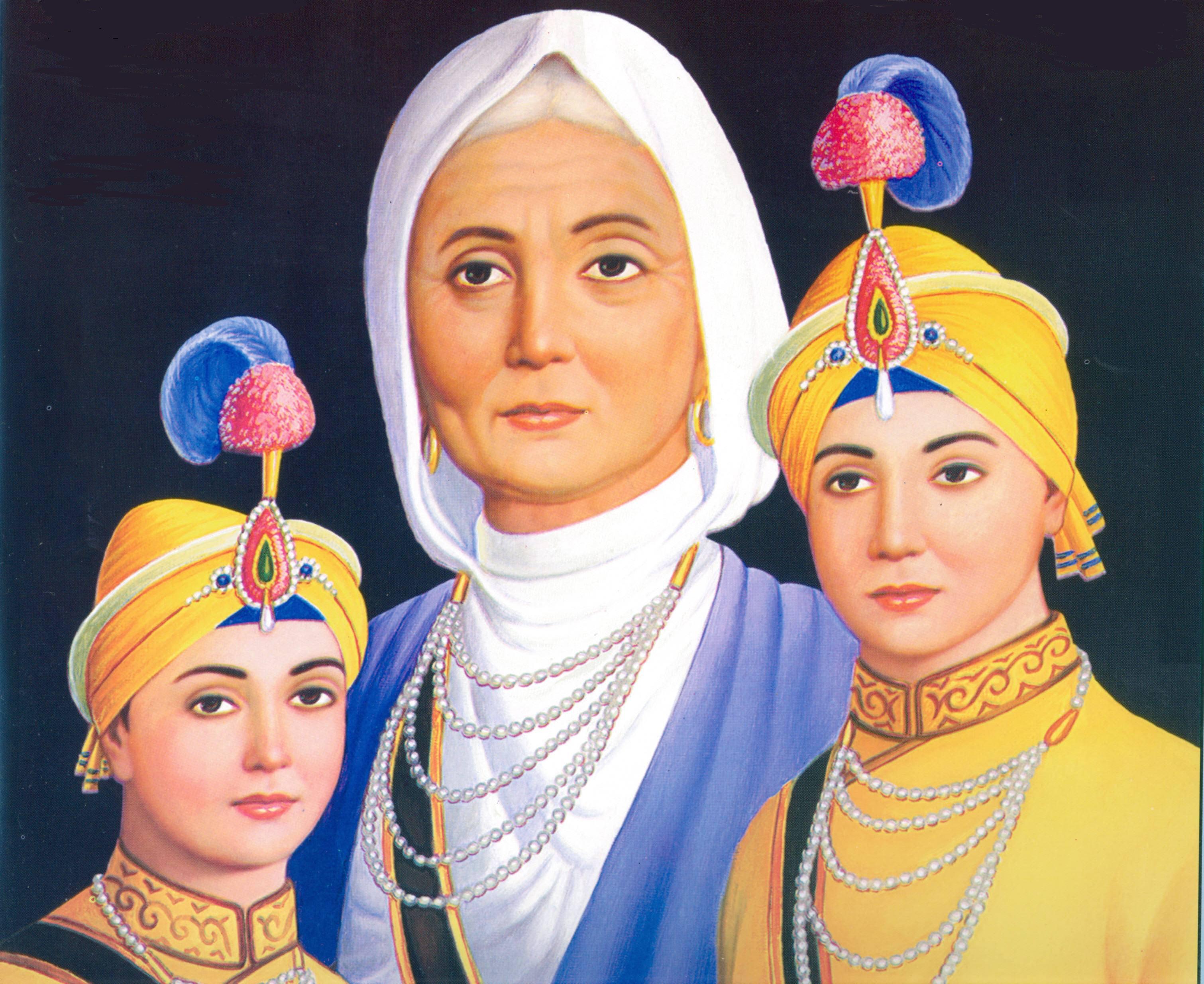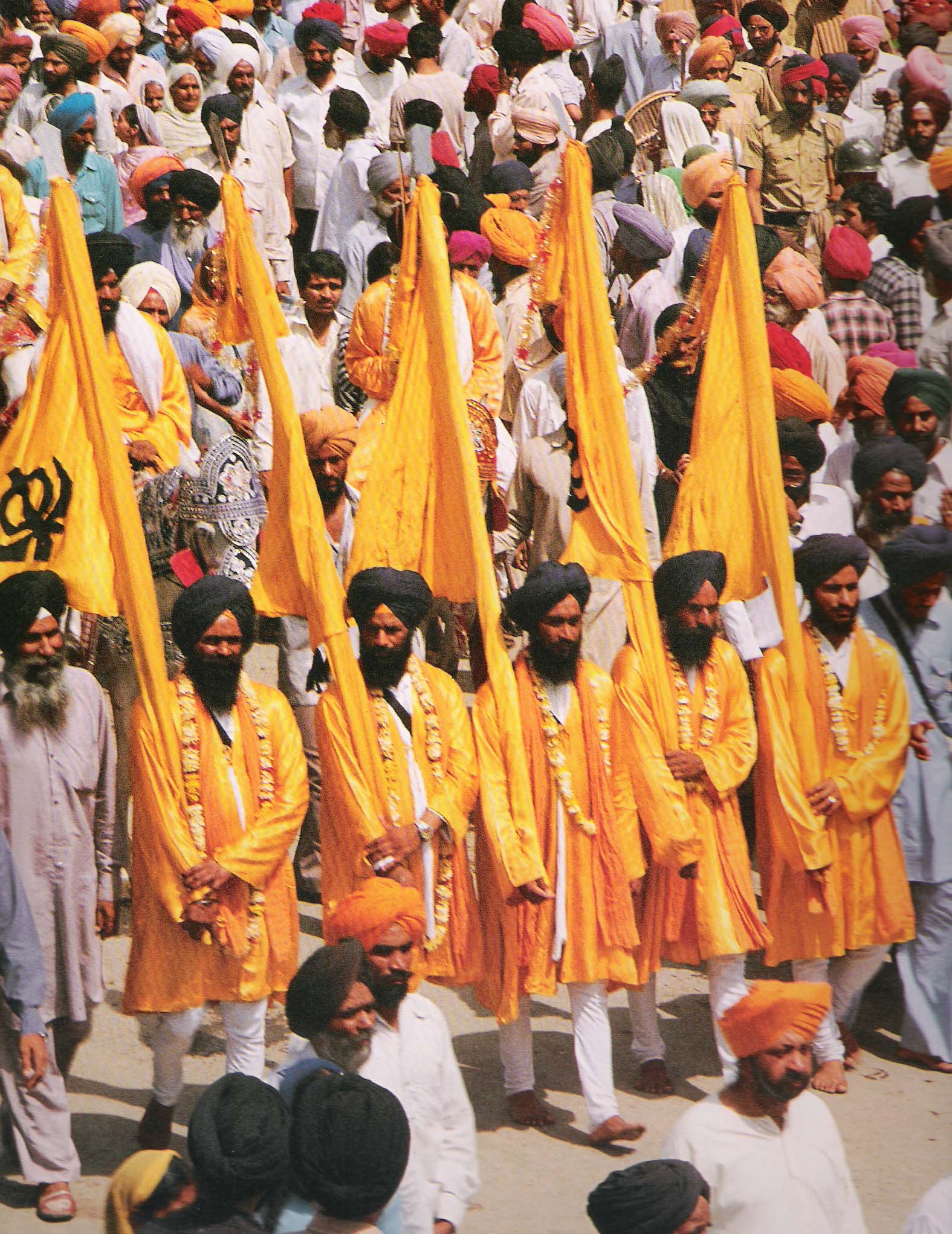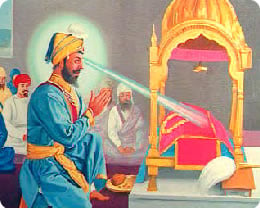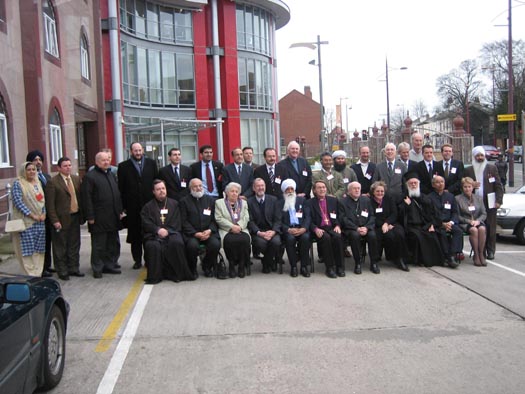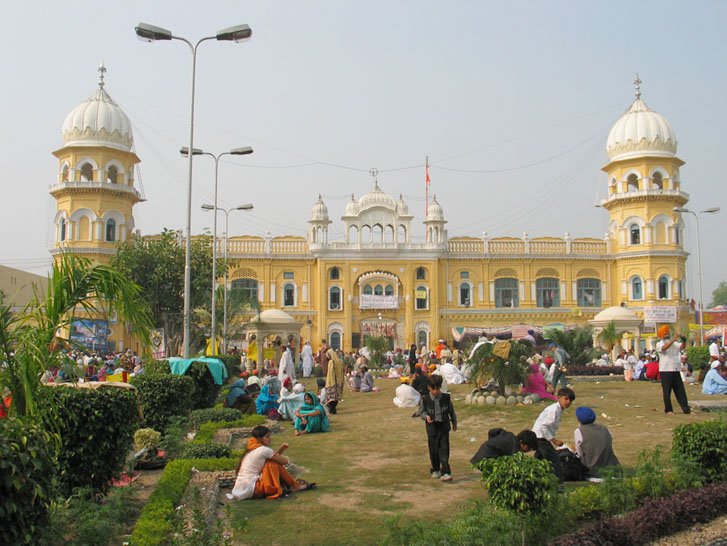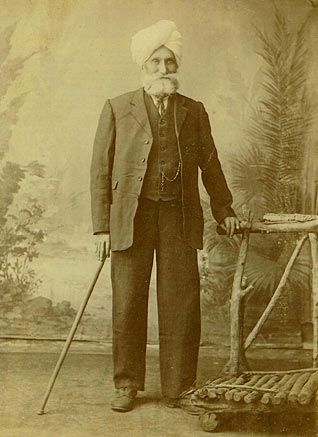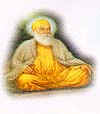AOW 1 to 99
Archived list of previously featured articles (AOW - Article of the Week) Original format - Full screen width.
- New Format - Half screen width - Archived Articles of the Week
- AOW 100 to 199
- AOW 200 to 299
- AOW 300 to 399
- Proposed Featured Articles
Contents:
Top 1 2 3 4 5 6 7 8 9 10 11 12 13 14 15 16 17 18 19 20 21 22 23 24 25 26 27 28 29 30 31 32 33
34 35 36 37 38 39 40 41 42 43 44 45 46 47 48 49 50 51 52 53 54 55 56 57 58 59 60 61 62 63 64 65 66
67 68 69 70 71 72 73 74 75 76 77 78 79 80 81 82 83 84 85 86 87 88 89 90 91 92 93 94 95 96 97 98 99
- Select all the Pictures of the Week: ALL POW
- Select all the Guru's Messages: All Guru's Messages
- This is a list of all Article of the Weeks: AOW 1 to 70
1
The SikhiWIKI encyclopedia was a brand new experiment started in February 2005. The idea was to organise a web based encyclopedia of the Sikh Way of Life written collaboratively by many of its readers.
Lots of people have contributed to this experiment and many are constantly improving SikhiWIKI, by continuously making changes, all of which are recorded on the page history and the 'Recent Changes' page.
Nonsense and vandalism are usually removed quickly. Feel free to dive in take a look at the Tutorial, play in the sandbox, get comfortable and start contributing to our SikhiWIKI!. Remember this is Sewa for the Panth! Read more here
Our motto is: "Anything is possible! We are vast and unlimited." Your tax-deductible gift to SikhiWiki is what will make the SikhiWiki service fast, reliable, and give it the resources needed for continued growth. We are building SikiWiki to last. It is a long-term project - a gathering place for us and our children as well as a legacy to future generations. .....More
Contents: Top 1. 10. 20. 30. 40. 50. 60. 70. 80. 90.
2
Bhai Kanhaiya (1648 - 1718), was a Sikh of Guru Tegh Bahadur and was the founder of the Sevapanthi or Addanshahi sect of the Sikhs. Bhai Sahib was born in a Dhamman Khatri family of Sodhara near Waxirabad in Sialkot district (now in Pakistan).
His father was a wealthy trader, but he himself being of a religious bent of mind left home when still very young and roamed about with sadhus and ascetics in search of spiritual peace. Bhai Sahib’s contribution to Sikhi:
- "Fore-runner of the Red Cross Movement,"
- "Treat all Human beings as equal"
- “Selfless service to All without Discrimination”
His quest ended as he met Guru Tegh Bahadur (1621 - 1675) and accepted initiation at Guru Ji hands. .....More
Contents: Top 1. 10. 20. 30. 40. 50. 60. 70. 80. 90.
3
Gurmat Sangeet or Shabad Kirtan has been an integral part of Sikh worship from the very beginning. Hymn-singing was in fact the earliest form of devotion for the Sikhs.
Even during the time of Guru Nanak, the disciples assembled together to sing shabads, i.e. hymns composed by the Guru which render praise to the Lord. Thus, Kirtan has been appropriated into the regular Gurdwara service for a long time.
Although Kirtan can be very touching and soul-stirring, Sikh kirtan abstains from all outward expression or frenzy in the form of clapping and dancing. Praise is offered to the Supreme Being who is without form, nirankar and not to a deity in any embodiment or incarnation.
The texts of shabad kirtan are from the Holy Book of Sikhs known as the Guru Granth Sahib, or Adi Granth, compiled by Guru Arjan in 1604 or from from the Dasam Granth and also sometimes from the compositions by Bhai Gurdas or Bhai Nand Lal. Probably no other religion shows a closer relationship between music and its scriptures than does Sikhism. The Holy Book is organized according to ragas, 31 in number, to which the poetic hymns belong. .....More
Contents: Top 1. 10. 20. 30. 40. 50. 60. 70. 80. 90.
4
When Farid ji was just a few years old, his mother taught him his prayers. The boy asked what was gained by his prayers. His mother replied 'sugar'.
Accordingly, she used to hide some sugar under his prayer-carpet, and when he had finished his prayers, she would draw the mat forth, and give the sugar to Farid as a reward for his devotion.
On one occasion, when his mother was absent, he prayed a great deal, and, it is said, a great supply of sugar - a miraculous gift from God - was found under his carpet. Some he ate himself and the rest he gave to his playfellows. He related the circumstance to his mother on her return. It was then his mother gave him the surname Shakar Ganj, meaning a "treasury of sugar".
There are 134 hymns of Sheikh Farid incorporated in the Guru Granth Sahib. Many Sikh scholars ascribe them to Farid Shakarganj (1173 – 1265) of Pak Pattan, a disciple of the Sufi Qutbuddin Bakhtiyar Kaki. The tenth in succession to his post was Shaikh Brahm (Ibrahim), also known as Farid Sani or Farid the 2nd, and it is this Farid who Guru Nanak Dev ji met on two occasions. .....More
Contents: Top 1. 10. 20. 30. 40. 50. 60. 70. 80. 90.
5
In Sikhism, the holy scriptures have clearly stated that the Sikh woman must always be regarded as an equal with man and has all the rights and privileges enjoyed by a man.
She is considered to have the same soul as man and has same right to grow spiritually.
In this faith since about 1499, the Sikh woman is allowed to lead religious congregations, to take part in:
- Akhand Path (the continuous recitation of the holy scriptures),
- to perform kirtan – Sikh spiritual hymn singing set to music,
- to work as Granthi (priest) or preacher and
- to participate freely in all religious, cultural, social, political and secular activities.
Sikh women have played a glorious part in Sikh history and have proven themselves as equal in service, devotion, sacrifice and bravery. Examples of their moral dignity, Sewa (service) and self sacrifice are and will remain an ever-lasting source of inspiration for all the peoples of the world.
Women are the backbone of the history of the Sikhs; their culture, their values and their traditions - yet there is little written about the huge contribution by the Sikh women to the great history of this religion. .....More
Contents: Top 1. 10. 20. 30. 40. 50. 60. 70. 80. 90.
6
The turban is closely associated with Sikhism. Sikhism or Sikhi is the only religion in the world in which the wearing of a turban is mandatory for all adult males.
Vast majority of people who wear turbans in Western countries are Sikhs. The Sikh turban is also called the pagdi or dastaar, which is a more respectful word in Punjabi for the turban.
All these words refer to the garment worn by both men and to a lesser extent by women to cover their heads. Some women prefer to wear a chunni instead of a turban.
The dastaar is a headdress consisting of a long scarf-like single piece of fine cloth wound round the head or sometimes over an inner "hat" or patka. Traditionally in India, the turban was only worn by men of high status in society; men of low status or of lower castes were not allowed or could not afford to wear a turban.
Sikh's are famous for their distinctive turbans. The turban represents respectability, and is a sign of nobility. .....More
Contents: Top 1. 10. 20. 30. 40. 50. 60. 70. 80. 90.
7
We should not increase our burden of karmas by eating higher life forms. There is karmic value in every kind of thing we use in this world. The air we consume, the water we use, we have to pay for.
The light of the sun or moon is also not free...and this green grass is also to be paid for - nothing is free. Everything has a Karmic value.
Depending on the "Jun" (life-form), there is a price to be paid. Lower life forms have a lower price to pay. Fruits and plants have a lower spiritual price than animal life forms. So why take the higher burden?
We now refer to this sensitivity with new and fancy words like "our green foot print", "environmentally friendly", "eco-friendly", etc. However, all these words narrow down to a way of life that does the least damage to the world.
If you are to construct a house, you don't make it using gold or silver or jewels. If you can, you make the house of stone - Stone is very strong and cheap. So, why don't you make your own house with stone and brick instead of gold? This body is like a house. .....More
Contents: Top 1. 10. 20. 30. 40. 50. 60. 70. 80. 90.
8
Ardas is a unique prayer; It's an appeal to Waheguru; a way to address and petition the Almighty; to gain spiritual energy; to connect with God.
It is a very well-known Sikh prayer that was not written in its entirety by the Gurus. The Ardas is an ever changing plea, the contents of which depend on local concerns and personal issues.
The word Ardĝs ( ਅਰਦਾਸ ) is derived from Persian word 'Arazdashat', meaning a request, a supplication, a prayer, a petition or an address to a superior authority.
The power that this single prayer possesses is astonishing. Starting with "Pritham bhagautee simar kai, Gur Nanak laee dhiaa-e" and ending with "Naanak naam charhdee kalaa, tayray bhaanay Sarbat da bhala". The ardas encompasses so many Sikh and Humanistic values. It is more than just a prayer; it is a new concept of therapy for the elevation of the human spirit, mind and body.
The Ardas is usually done standing up with folded hands. The beginning of the Ardas is strictly set by the tenth Sikh Guru, Guru Gobind Singh. When it comes to the conclusion of this prayer, the devotee uses the word Waheguru .....More
Contents: Top 1. 10. 20. 30. 40. 50. 60. 70. 80. 90.
9
In October/November every year, the Sikhs celebrate the birthday of Guru Nanak Dev, the founder of their religion; a youngish faith system called Sikhism. Although many in the world have not learnt about Guru Nanak, his contribution to our understanding of life and its deep meaning is immense. Why not learn more about the Guru's contributions to Sikhi and how this has benefited humanity?
Guru Nanak was born on April 15, 1469 but this year (2015), the Sikhs will celebrate this auspicious and momentous day on November 25. Next year (2016) this day will be celebrated on November 14.
Guru Nanak Dev came into this world at a time of extreme doom and gloom when the moral standards of the ruling class had vanished; the rulers had no respect for humanity; and law of the jungle prevailed everywhere. Men’s ideas and aspirations were at an all time low.
Materialistic wealth, plain greed and illusion of Maya fascinated the world and led everyone astray. Good acts and righteous behaviour no longer commended themselves to humans. .....More
Contents: Top 1. 10. 20. 30. 40. 50. 60. 70. 80. 90.
10
On November 24, the Sikhs remember the Martyrdom of Guru Tegh Bahadur, their ninth Guru.
An extremely important event in Sikh history that had a profound impact on the future direction of Sikhism, the religion of the Sikhs. Guru Tegh Bahadur undertook the supreme sacrifice for the protection of the most fundamental of human rights - the right of a person to freely practice his or her religion without interference or hindrance.
In the modern day we tend to take this freedom for granted – but in 1675, millions of people were denied this basic right.
However, what is even more astonishing is the fact that the Guru was not protecting the right of the Sikhs to practise their religion but instead the rights of non-Sikh peace-loving people from Kashmir. These people from Kashmir were very respected Hindus who were being converted to Islam under the threat of death by the "Mughal" Emperor Aurangzeb. In 1669, the Mughal ruler Aurangzeb departed from the policy of tolerance practised by his predecessors and unleashed instead a policy of religious persecution against non-Muslims. .....More
Contents: Top 1. 10. 20. 30. 40. 50. 60. 70. 80. 90.
11
Langar or free kitchen was started by the first Sikh Guru, Guru Nanak Dev Ji. It is designed to uphold the principle of equality between all people of the world regardless of religion, caste, colour, creed, age, gender or social status.
In addition to the ideals of equality, the tradition of Langar expresses the ethics of sharing, community, inclusiveness and oneness of all humankind. "..the Light of God is in all hearts." (sggs 282).
For the first time in history, Guruji designed an institution in which all people would sit on the floor together, as equals, to eat the same simple food. It is here that all people high or low, rich or poor, male or female, all sit in the same pangat (literally "row" or "line") to share and enjoy the food together.
The institution of Guru ka Langar has served the community in many ways. It has ensured the participation of women and children in a task of service for mankind. Women play an important role in the preparation of meals, and the children help in serving food to the pangat. Langar also teaches the etiquette of sitting and eating in a community situation, which has played a great part in upholding the virtue of sameness of all human beings; providing a welcome, secure and protected sanctuary. .....More
Contents: Top 1. 10. 20. 30. 40. 50. 60. 70. 80. 90.
12
Sikhism is one religion, which is founded on the principles of global Interfaith communities and mutual Inter-community respect and harmony. The founders of Sikhism have, since 1469, defined and preached the principles of interfaith respect, dialogue and harmony.
A Sikh by definition must respect and accept all other world religions. Guru Nanak, the founding Guru of the Sikh faith said, "Your [God's] Divine Light is contained in all; everyone belongs to You." (SGGS page 414) So in this religion the holiness of all humans is recognised and respected, irrelevant of the person's religion.
Further, the Sikh must protect, guard and allow the free-practise of the customs and rituals of other religions. The SGGS says on page 142: One who recognizes that all spiritual paths lead to the One shall be emancipated.
The following are remarks made by distinguished personalities about the Sri Guru Granth Sahib and its interfaith message:
Arnold Toynbee: The Adi Granth is remarkable for several reasons. Of all known religious scriptures this book is the most highly venerated.
Pearl S. Buck: They (the Sikh Scriptures) speak to persons of any religion or of none. They speak for the human heart and the searching mind.
Dr. S. Radhaknshnan: The barriers of seas and mountains will give way before the call of eternal truth which is set forth with freshness of feelings and fervour of devotion in the Adi Granth. .....More
Contents: Top 1. 10. 20. 30. 40. 50. 60. 70. 80. 90.
13
On January 5 this year the world celebrates the birth in Patna, India of the tenth and last of the Ten Gurus in human form of Sikhism.
Gobind Rai was born on January 5, 1666 and became Guru on November 11, 1675 at the age of nine, following in the footsteps of his father Guru Teg Bahadur.
The Guru moulded the Sikh religion into its present form with the formation of the Khalsa in 1699.
The tenth Guru (teacher) of the Sikh faith, was born Gobind Rai. It may not be out of the way to say here that throughout the annals of human history, there was no other individual who could be of more inspiring personality than Guru Gobind Singh.
Guru ji infused the spirit of both sainthood and solider in the minds and hearts of his followers to fight oppression and support righteousness (Dharma) in order to restore justice, peace and to uplift the down-trodden people in this world. In the short 42 year of life and a Guruship of only 33 years, the Guru contributed immensely to Sikhism and to the world and his gift to all the peoples of the world still remains unmatched to this day. .....More
Contents: Top 1. 10. 20. 30. 40. 50. 60. 70. 80. 90.
14
On January 31, the Sikh community worldwide celebrate the birthday of the seventh Sikh Guru, Guru Har Rai (Gurmukhi: ਗੁਰੂ ਹਰਿ ਰਾਇ) (31 January 1630 - 20 October 1661).
Guru ji was the son of Baba Gurdita and Mata Nihal Kaur. Baba Gurdita was son of the sixth Guru, Guru Hargobind. Although, Guru Har Rai was a man of peace, he never disbanded the armed Sikh warriors (Saint Soldiers), who earlier were maintained by his grandfather, Guru Hargobind.
He always boosted the military spirit of the Sikhs, but he never himself indulged in any direct political and armed controversy with the contemporary Mughal Empire. Once on the request of Dara Shikoh (the eldest son of emperor Shah Jahan), Guru Sahib helped him to escape safely from the bloody hands of Aurangzeb's armed forces during the war of succession.
Guru Sahib also established an Aurvedic herbal medicine hospital and a medical research centre at Kiratpur Sahib. There also he maintained a zoo. Once Dara Shikoh, the eldest son of Shah Jahan fell seriously ill by some unknown disease. The best physicians available in the country and abroad were consulted, but there was no improvement. .....More
Contents: Top 1. 10. 20. 30. 40. 50. 60. 70. 80. 90.
15
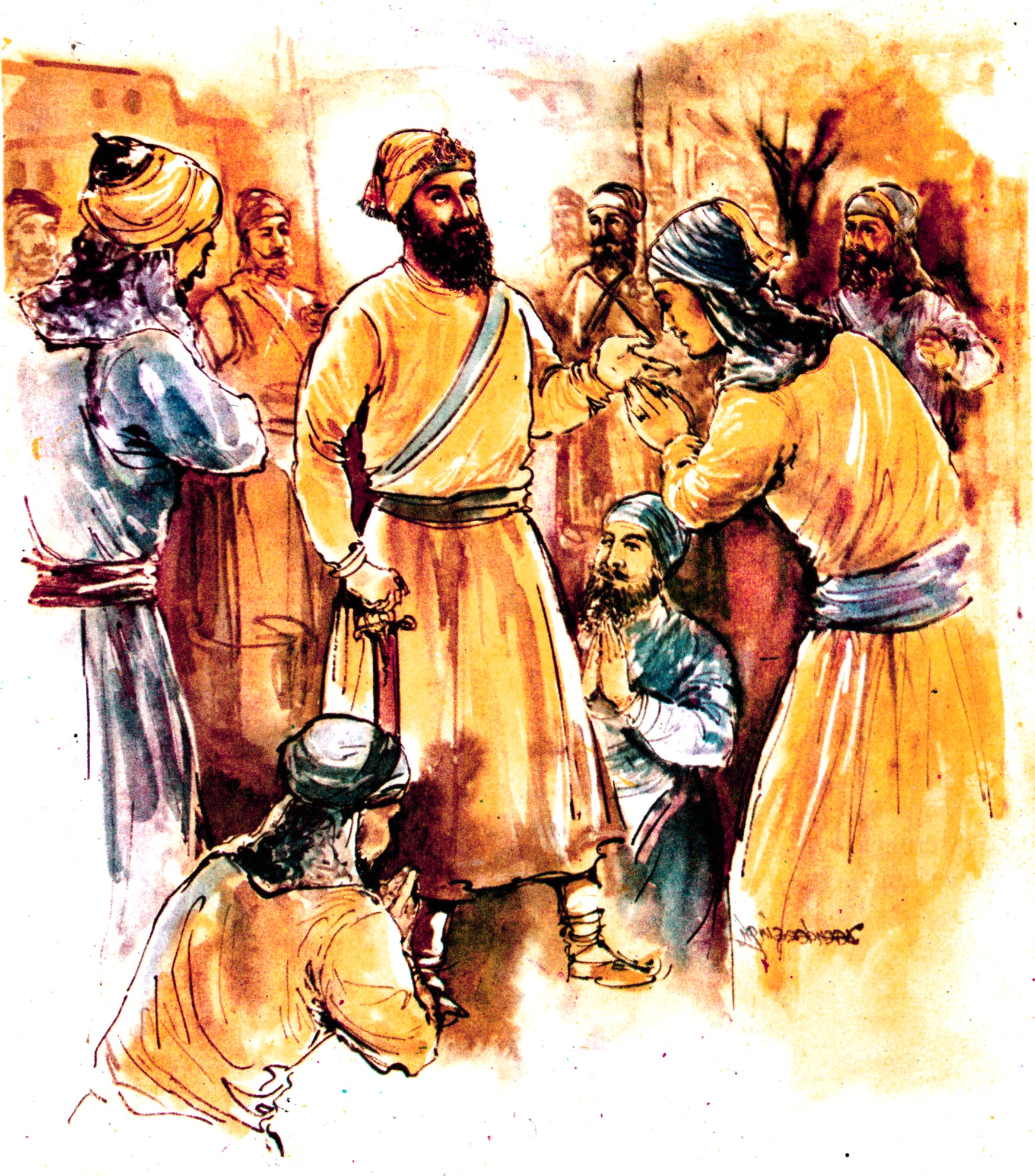
Sahibzada Ajit Singh (11 February 1687 - 7 December 1705), the eldest of four sons of Guru Gobind Singh, was born to Mata Jito ji (also known as Mata Sundari ji) at Paonta sahib on 11 February 1687. The following year, Guru Gobind Singh returned with the family to Anandpur sahib where Ajit Singh was brought up in the approved Sikh style.
He was taught the religious texts, philosophy and history, and had training in the martial arts such as riding, swordsmanship, gatka and archery. He grew up to be a handsome young man, strong, intelligent and a natural leader of people. Soon after the creation of the Khalsa on 30 March 1699, he had his first test of skill. A group of Sikhs (sangat) coming from Pothohar, northwest Punjab, was attacked and looted on the way by the Ranghars of Nuh, a short distance from Anandpur across the River Sutlej.
Guru Gobind Singh sent Sahibzada Ajit Singh, barely 12 years of age then, to that village to intervene, defend the sangat and deal with the intruders. Ajit Singh at the head of 100 Sikhs reached there on 23 May 1699, punished the Ranghars and recovered the looted property. .....More
Contents: Top 1. 10. 20. 30. 40. 50. 60. 70. 80. 90.
16
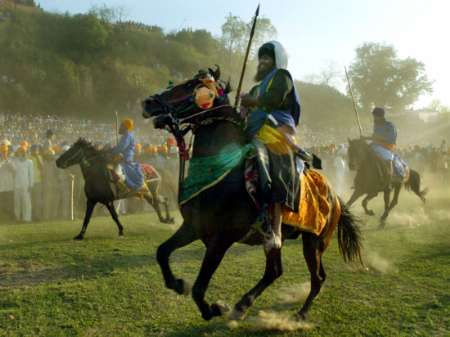
(Photo:Reuters/Kamal Kishore)
Hola Mohalla or simply "Hola" is a Sikh festival that takes place on the first "full moon" day in the month of March which approximately corresponds to the Punjabi month of Chet which begins on March 14.
Chet is the first month in the Nanakshahi calendar and this month coincides with March-April in the Western calendar.
Every year this festival takes place in the month of March when we have a "full moon" in India. This Sikh festival follows the Hindu festival of Holi; The word "Mohalla" is derived from the Arabic root "hal" (alighting, descending) and is a Punjabi word that implies an organized procession in the form of an army column.
But unlike Holi, when people playfully sprinkle color, dry or mixed in water, on each other, the Guru made Hola Mohalla an occasion for the Sikhs to demonstrate their martial skills in simulated battles.
Together the words "Hola Mohalla" stands for "mock fight". During this festival, procession are organised in the form of army type columns accompanied by war-drums and standard-bearers and proceeding to a given spot or moving within the state from one gurdwara to another. .....More
Contents: Top 1. 10. 20. 30. 40. 50. 60. 70. 80. 90.
17
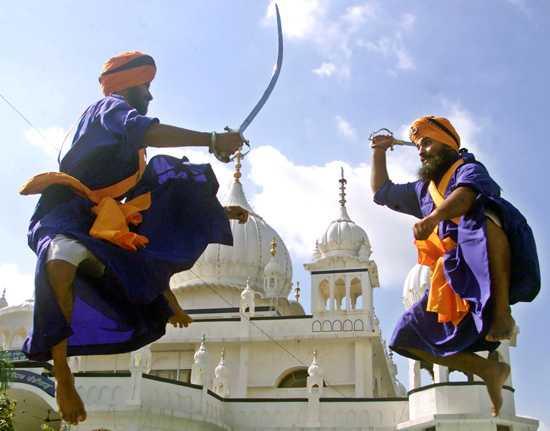
Gatka is an ancient martial art which has been thoroughly battle-tested and has existed in northern India for many thousands of years.
Although it uses the sword or (kirpan) as its primary weapon, many other weapons are available to the Gatka master.
Today, this art exists exclusively amongst the Sikhs who have passed down the flamboyant techniques through generations, since their sixth Guru, Guru Hargobind wore the two swords of Miri (temporal, worldly) and Piri (spiritual, transcendental).
The Sikhs have been responsible for the revival of this early art ensuring it's survival despite mass persecution of the native population in India by foreign invaders like the Mughals and others for many hundreds of years.
Gatka is a complete martial system which uses spiritual, mental and physical skills in equal portions to help one become fully competent in defending themselves and others. It is a system that can only be used as a last resort: "When all other means have failed, it is proper to take the sword in one’s hand" (Guru Gobind Singh) .....More
Contents: Top 1. 10. 20. 30. 40. 50. 60. 70. 80. 90.
18
On 16 June of every year since 1606, the Sikhs have commemorated the martyrdom of their first martyr, the fifth Guru, Guru Arjan Dev. Sikh history until then had been peaceful and non-violent.
All the Sikh Gurus had taught the message of compassion, love, dedication, hard work, worship of one God and the commitment to peace and harmony for all the peoples of the world. During the Guruship of Guru Arjan many thousands of the native people had began to follow the teachings of Sikhism and both the Hindus and Muslims were crowding to Govindwal, the centre of Sikhs during the late 1500's.
After the death of Mughal Emperor Akbar in 1605, his son Jahangir became the leader of India. Unlike his father, Jahagir was a fundamentalist Muslim, obsessed with turning the country into an Islamic state. Both Hindu and Muslim fundamentalists concerned at the rapid increase in the popularity of Guru Arjan, moved the new head of state Emperor Jahangir against the Guru. Jahangir himself was also jealous about Guru's propagation of Sikhism.
He promptly obliged the enemies of the Guru. Many baseless allegations were levelled against Guru Sahib, one of those was helping the rebellious Khusrau, who was Jahangir's son and the preferred choice of Akbar to be the next ruler of India rather than his son Jahangir, who was given to drinking wine and taking opium. .....More
Contents: Top 1. 10. 20. 30. 40. 50. 60. 70. 80. 90.
19
On the 2 May every year, the Sikhs celebrate the birthday of their spiritual master, Guru Arjan Dev, the fifth Guru of the Sikhs. Guru ji was the embodiment of Godly devotion, Selfless Service and Universal Love. He was the treasure of celestial knowledge and spiritual excellence.
He substantially contributed towards the welfare of society and the formation of the Sikh faith. He stood steadfastly for the principles he believed in, even sacrificed his own life, and attained a unique and unparalleled martyrdom in the history of mankind.
Guru Ji was born on May 2, 1563, in the house of Guru Ram Das, the fourth Guru of the Sikhs. He was the youngest of the three sons of the fourth Sikh Guru. Guru Ram Das envisioned heavenly qualities in his youngest son Arjan.
From childhood Guru Ram Das found him imbued with Naam, the remembrance, love and affinity with God and always immersed in tranquil bliss. The Guruship was destined to be bestowed upon Guru Arjan. It is said that one day, baby Arjan crawled up on the Divine throne of his maternal grandfather, Guru Amar Das the third Guru, and sat there comfortably. The Guru smiled and prophesied, “Maternal Grandson will ship the Naam across.”
Although he ascended the throne of Guru Nanak at a young age of 18, he was far more advanced in wisdom and spiritual understanding than his tender age. The letters he wrote to his father from Lahore, not then even a teen-aged boy, stand testimony to this fact (see Shabad Hazaray}. .....More
Contents: Top 1. 10. 20. 30. 40. 50. 60. 70. 80. 90.
20
Guru Amar Das
Every year on 23 May, the Sikh celebrate the birthday of their third Guru, Sri Guru Amar Das. It is recorded that before becoming a Sikh, Bhai Amardas as he was known at the time, was a very religious Vaishanavite Hindu who spent most of his life performing all of the ritual pilgrimages and fasts of a devout Hindu. One day, Bhai Amardas heard some hymns of Guru Nanak being sung by Bibi Amro Ji, the daughter of Guru Angad, the second Sikh Guru. Bibi Amro was married to Bhai Sahib's brother, Bhai Manak Chand's son who was called Bhai Jasso.
Bibi Amro lived together with Bhai Sahib's brother. It so happened that Bhai Sahib was at his brother house when he heard the wonderful recitation of Gurbani by his niece-in-law. Bhai Sahib was so impressed and moved by these Shabads that he immediately decided to go to see Guru Angad at Khadur Sahib. It is recorded that this event took place when Bhai Sahib was 61 years old.
Bhai Sahib also had a younger brother called Bhai Ishar Das who had a son called Bhai Gurdas, who was a superb poet and scholar of comparative religion who would later go on become the scribe of the first edition of the Guru Granth Sahib.
In 1635, upon meeting Guru Angad, Bhai Sahib was so touched by the Guru's message that he became a devout Sikh. Read more .....
Contents: Top 1. 10. 20. 30. 40. 50. 60. 70. 80. 90.
21
On 5 July every year, the Sikhs celebrate the birthday of their sixth Master, Guru Har Gobind (5 July 1595 - 19 March 1644).
Guru sahib was born at village Guru Ki Wadali in district Amritsar on 5 July 1595 and was the only son of Mata Ganga and Guru Arjan, whom he succeeded on 11 June 1606 at the age of only 11 years old.
The young Hargobind received his early education and training from the revered Sikhs leaders of the time Baba Buddha, the first granthi and Bhai Gurdas, the scribe of the Sikh holy script, Guru Granth Sahib.
Guru Hargobind was married in about 1610 to Mata Nanaki also known as Mata Marwahi or Mata Mahadevi. They were endowed with a large family consisting of one daughter Bibi Viro and five sons: Baba Gurditta, Suraj Mal ji, Ani Rai ji, Atal Rai ji and Tegh Bahadar ji.
Guru Hargobind was responsible for wearing two kirpans - one for Miri (temporal protection) and one for Piri (spiritual reasons) and began the rapid and irreversible militarization of the Sikh people. It was due to the tragic martyrdom of his father, Guru Arjan that the sixth Guru changed the Panth into an effective, brave and determined army of religious supporters. .....More
Contents: Top 1. 10. 20. 30. 40. 50. 60. 70. 80. 90.
22
On the 4 June every year, the worldwide Sikh community celebrate the birthday of late Bhagat Puran Singh (1904 - 1992). Bhai Sahib was born at Rajewal, in district Ludhiana, Punjab, India on June 4, 1904.
His mother was Mehtab Kaur and his father's name was Chaudhari Chibu Mal. Bhai Sahib was born into a Hindu family and his original name was Ramji Das. He started his education at Khanna, Punjab and then later joined Lahore's Khalsa High School.
As a young man, he used to perform "sewa" at Gurdwara Dera Sahib and Gurdwara Shahid Ganj in Lahore. Here, he would help with cleaning, cooking and serving food; he also tended to the aged, infirm and sick who came to the Gurdwaras to pay their respect to Guru Granth Sahib.
In an interview with Bhai Patwant Singh, Bhagat Puran Singh discloses how he became a Sikh. In his early life he used to travel a lot from village to village and would stay overnight at a Hindu Temple. One day when he was staying at one such temple, the Brahmins told him to clean the temple and then when he had done that, they sat in front of him and started eating food without offering him anything.
The next time, he had to stay at a Gurdwara and the priest there not only gave him food but also a cot and a glass of milk afterwards .....More
Contents: Top 1. 10. 20. 30. 40. 50. 60. 70. 80. 90.
23
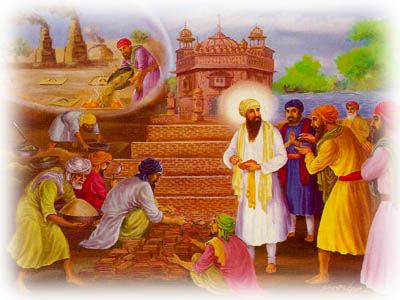
Dasvandh or Dasaundh, literally means a "tenth part" and refers to the practice among Sikhs of contributing in the name of the Guru one-tenth of their earnings towards the common resources of the community.
This is their religious obligation — a religious requirement or duty; a form of seva or humble service which is highly valued in the Sikh system.
The concept of dasvandh was implicit in Guru Nanak’s own Gurbani in the line: "ਘਾਲਿ ਖਾਇ ਕਿਛੁ ਹਥਹੁ ਦੇਇ ॥ ਨਾਨਕ ਰਾਹੁ ਪਛਾਣਹਿ ਸੇਇ ॥੧॥ One who works for what he eats, and gives some of what he has - O Nanak, he knows the Path (1)" (SGGS p 1245)
The idea of sharing and giving is symbolised by the institutions of langar (community kitchen) for the sangat (holy assembly) that the Guru has established.
In the time of Guru Amar Das, Nanak III, a formal structure for channelizing Sikh religious giving was evolved. The Guru set up 22 manjis or districts in different parts of the country, each placed under the charge of a pious Sikh who, besides preaching Guru Nanak's word, looked after the sangats within his/her jurisdiction and transmitted the disciple’s offerings to the Guru. .....More
Contents: Top 1. 10. 20. 30. 40. 50. 60. 70. 80. 90.
24

Rehat Maryada is the Sikh Code of Conduct by which all Sikhs need to regulate their lives and to control their needs and actions. This Code of Conduct is the guideline by which a Sikh should live his or her life.
The main theme through this regulation is the reliance on a "disciplined life" – a Sikh is bound by the Guru to lead a simple life where the mind has a control over the various desires and urges that are trying to overpower the person's mind.
The Guru tells us that for a "pure" Sikh, "True are his actions; true are his ways." (SGGS p283) and "Those who speak are liberated, and those who listen are liberated; those who keep the Rehat (discipled code), are not reincarnated again." (SGGS p1230). In 1950 the SGPC formulated a formal Code of Conduct to provide guidelines for all Sikh individuals and communities around the world. Its implementation has resulted in a high level of uniformity in the religious and social practices of Sikhism. This Rehat Maryada provides some direct and effective guideline for a committed Sikh…....Continued
Contents: Top 1. 10. 20. 30. 40. 50. 60. 70. 80. 90.
25
A Sikh is required by the Sikh Gurus to live a disciplined and ordered life by doing pure and righteous deeds and actions. The following are activities that a Sikh should engage in:
Read Gurbani - The initiated Sikh is asked by the Panj Piare during the Amrit Sanchar ceremony to recite the 5 banis every morning as a commitment to the Sikh Gurus and Waheguru.
Wear the 5Ks or panj kakaar/kakke: These are the five items of faith that a baptised Sikh wears at all times as per the command of the tenth Sikh master, Guru Gobind Singh. The Five Ks are not merely symbols but articles of faith which collectively form the external visible symbols to clearly and outwardly advertise, display and identify the love of the Sikh for the Guru.
To kill the 5 Evils or five thieves referred to in Sikh Scripture; these are the five major weaknesses of the human personality at variance with its spiritual essence. They are: Kam (Lust), Krodh (Rage), Lobh (Greed), Moh (Attachment) and Ahankar (ego).
Practice the 5 Virtues - For Sikhs, the final goal of life is to reunite or merge with God (Mukti). The Sikh Gurus taught that to achieve this goal it was important to work hard at developing positive human qualities which lead the soul closer to God.
Simran and Sewa and also Three Pillars: Naam Japna, Kirat Karni and Vand Chakna .....More
Contents: Top 1. 10. 20. 30. 40. 50. 60. 70. 80. 90.
26
Seva or Karseva also shortened to ‘Sewa’ is a word used to refer to "selfless service", performed without any thought of reward or personal benefit.
The person performing this service is called a Sevadar. All Sikhs are encouraged by their Guru (Sri Guru Granth Sahib) to perform Seva or Selfless Service.
This is not only good for the community but is also good for the moral uplifting of the person performing the service. You will find Sikhs engaged in free service in Gurdwaras washing dishes, performing kirtan or cleaning the floors, etc.
Sikhs are also encouraged to help the community by performing unpaid work in hospitals, old peoples' homes, community centres, etc. Volunteers engaged in Seva or Sevadars find that this activity forms an essential part of their life, providing spiritual fulfilment and practical benefits.
Sikhism is founded on principles of "Sarbat da bhalla" - "working towards the common good". For Sikhs, this means reaching out to serve and to uplift all of humanity as an expression or devotion to the Creator. Many other Sikh institutes like Guru-ka-Langar, Kirtan, Paath, etc depend on the performance of Seva by many in the congregation. So the principles of Seva underpins many of the Sikh values and institutions - Such is the importance given to Seva in Sikhism. .....More
Contents: Top 1. 10. 20. 30. 40. 50. 60. 70. 80. 90.
27
Gurdwara Sahib Switzerland was not built in a few weeks, a few months or even a few years. It took a full decade to build this beautiful Gurdwara in Langenthal, Swiss Canton of Berne in northern Switzerland.
The Sikhs of Switzerland have toiled from 1996 until 2006 for the building to be built. The Sangat started this esteemed project in 1996 when they applied for permission to start construction of Gurdwara sahib. The process of seeking permission took nearly two years.
The foundation stone of Gurdwara sahib was laid on 11th January 2001. The ceremony was headed by Panj Pyara (five beloved). The prominent among the gathering were Singh Sahib Prof. Darshan Singh Ji and Giani Pritam Singh Ji from Damdami Taksal.
In fact, the actual construction work did not begin at the site until 25th October 2002. The prominent Sikh personality Bhai Harjinder Singh Ji (Srinagar wale) especially flew into Switzerland to grace this occasion. It was on this occasion that the daily construction work was commenced. Read more ......
Contents: Top 1. 10. 20. 30. 40. 50. 60. 70. 80. 90.
28
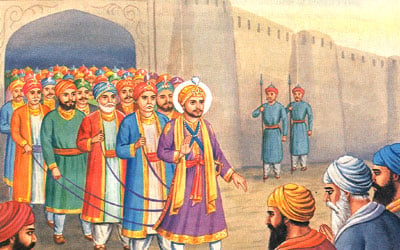
This year (2014) on October 23,(next year its November, 11) the worldwide Sikh community celebrates the return of the sixth Nanak from detention at Gwalior Fort on the same day in about October/November 1619.
This historic event coincides with the Hindu festival of Diwali. This has resulted in similarity of celebration amongst Sikhs and Hindus.
When Murtaja Khan, Nawab of Lahore, noticed that Guru Ji had constructed Sri Akal Takhat Sahib, 'The Throne of the Almighty', at Amritsar, and was also strengthening his army, he informed the Mughal Emperor Jahangir about this.
He also incorrectly emphasised that the Sikh Guru was making preparations to take revenge for his father's torture and martyrdom. When Jahangir came to know about this he at once sent Wazir Khan and Guncha Beg to Amritsar in order to arrest Guru Hargobind Sahib Ji.
But Wazir Khan who was a well-wisher of the Sikh Guru’s requested the Guru to accompany them to Delhi as Emperor Jahangir wanted to meet him. .....More
Contents: Top 1. 10. 20. 30. 40. 50. 60. 70. 80. 90.
29
On the first weekend in April every year, Sikhs worldwide remembered the fallen Indian soldiers of World War 1 & 2. It was during the weekend of 2-4 April 1999, when hundreds of Sikhs from Belgium, the Netherlands, France and Britain first gathered in the Belgian town of Ypres (Ieper) to combine a celebration of Vaisakhi, the 300th anniversary of the birth of the Khalsa with a commemoration of the Indian soldiers who fell in the First World War in the former front zone around Ypres, the so-called Ypres Salient in Belgium.
This article elaborates on how this event originated, and on how it bound together two very different groups of people whose paths first crossed during the Great War. Beyond doubt, this was one of the most remarkable commemorations of the First World War (1914-1918) that has ever taken place on these former battlefields. It was a unique event in other ways as well. It was unusual in that Ypres has no Sikh community: why then celebrate Vaisakhi in this small town, while most Belgian Sikhs live at the other end of the country or in Brussels, where they have Gurdwaras of their own? Continued...
Contents: Top 1. 10. 20. 30. 40. 50. 60. 70. 80. 90.
30
Bhai Avtar Singh (1925-2006) It is with great sorrow that the Sikh community acknowledges the loss of their most dedicated Gurbani Kirtania who passed away peacefully at about 10.50 PM (IST) on Friday, November 24th, 2006. Bhai Sahib was aged 81 years and was at his residence in India with his whole family present when this sad event took place. Bhai Sahib has always been an ardent exponent of Gurmat Sangeet and has practised the traditional style of Kirtan in keeping with the historic melodies of Guru's Ragas. He had travelled widely and his Sewa for the Panth will be dearly missed. Lately, he had stopped his journeys abroad as he was suffering with Leukaemia.
Many Gurdwaras around the world held services in his honor and prayers were said for the support of his departed soul and for the support of his family. May Waheguru shower His blessings on this faithful supporter of the Dharma and may the Almighty give strength to his family so they may be able to endure His Hukam. ... Continued.
Contents: Top 1. 10. 20. 30. 40. 50. 60. 70. 80. 90.
31
Many sacred Sikh shrines can be found in the Sikh holy city of Amritsar. Of particular importance are the five sacred pools in this city.
These are called sarovars and it is the practice of some Sikhs to have a dip in all five of these holy pools. The ritual, apart from being good exercise, acquaints one with the importance of these five sites.
These five holy Sarovars are: Amritsar (1586) (now used more to refer to the city rather than the sarovar), Santokhsar (1587-88), Ramsar (1602-03), Kaulsar (1627), Bibeksar (1628). Among these famous five historical shrines is the famous Gurdwara, Ramsar. This is located south to south-east of the most important landmark for the Sikhs, Harimandir Sahib.
Alongside the Ramsar Gurdwara is situated the smallest of the five sarovars called Ramsar. This is the location where in 1603, Guru Arjun Dev, the fifth Sikh Guru spent over a year in semi-seclusion along with his scribe, Bhai Gurdas to compile the holy Adi Granth, the sacred Sikh scripture for the first time. .....More
Contents: Top 1. 10. 20. 30. 40. 50. 60. 70. 80. 90.
32
Gurdwara Baba Atal Sahib is situated to the south of the Harimandir Sahib or Golden Temple, about 185 metres from Sarai (living accomodation) Guru Ram Das.
The nine-storey octagonal tower, standing 40 metres high, is the tallest building in Amritsar.
Originally a samadhi, or cenotaph, enshrining the remains of Baba Atal Rai, a son of Guru Hargobind, the sixth Guru of the Sikhs.
However, it was transformed, with the passage of time, into a gurdwara, because, in India, "the process of deification is aided by the tendency to develop the tomb raised over a man of eminence into a temple".'
According to popular tradition, Atal Rai, at the age of nine, restored his close friend Mohan, son of a widow, to life after his sudden demise. Guru Hargobind considered his son's act as being against the Sikh tradition and rebuked him for performing a feat involving a miracle and warned him that one's spiritual power should be displayed "in purity of doctrine and holiness of living". It is said that Atal Rai told his father that he would lay down his own life for breaking the law of nature by reviving his friend from the dead. .....More
Contents: Top 1. 10. 20. 30. 40. 50. 60. 70. 80. 90.
33

Every year on December 21, the Sikh community honors the two elder sons of Guru Gobind Singh who on this day in 1705 showed the world how to fight in battle; no matter how young you may be - the duty to Dharam and country comes first; before personal needs, pleasure and comforts.
It was around this time of the year that about 40 Sikhs in a mud fort were surrounded by over a 100,000 enemy soldiers. Then Baba Ajit Singh went before Guru Sahib and said, "Pita ji (dear father), permit me to go and fight on the battleground and grace me with the opportunity to make my life fruitful and worthy in service of the panth."
Guru Gobind Singh hugged his beloved son and gave him a Shastr (weapon). Every father wants to see their child get married, but this was the time to fight the enemy and defend the path of righteousness. Death was waiting and today Baba Ajit Singh would be marrying death.
The sun was about to rise. Guru saw that Nawab Wazir Khan wanted to take the fort of Chamkaur in one attempt. The Nawab surrounded the fort with his armies. Baba Ajit Singh boldly and valiantly came out of fort, accompanied with 5 other Singhs, .....More
Contents: Top 1. 10. 20. 30. 40. 50. 60. 70. 80. 90.
34
Village of Children Something about the village graveyard set it apart. During my travels I had seen literally hundreds of graveyards. Usually graveyards are somber and somewhat resigned under the weight of death. But this one was different: besides been well-kept - which in itself was not unusual - it was designed more like a garden of life than a cradle of death.
What set it truly apart was the cheerfulness of its structure. Its' shady trees and sunny flowers seductively invited me in. Graveyards were my favourite resting places. It seemed that as soon as one exited a womb, Maya (worldy attractions) became a human's sole companion until the gates of a graveyard. Perhaps it was the absence of Maya in such places that kept my hopes of enlightenment alive.
I had left home when I had turned twenty. Although I didn't know it then, I had set out to find a place free of illusions. I had travelled to majestic temples, sober ashrams, holy rivers, renowned sadhus and any other religious place I had been told about, yet my mind was as restless as it was when I had first started. The holy places and the holy people at these places were among the most devout followers of Maya. .....More
Contents: Top 1. 10. 20. 30. 40. 50. 60. 70. 80. 90.
35
After teaching people in Lahore to live honestly Guru Nanak ji returned to Talwandi to see his parents.
Then after a short stay, he proceeded with Mardana, his long time companion on a extensive journey to visit the sacred places of pilgrimage of the Hindus. On the way they reached Bhai Lalo’s workshop at Saidpur, presently known as Eminabad in Pakistan.
Bhai Lalo earned his living by honest work or Kirat Karni. He was nearly seventeen years older than Guru Nanak. When Lalo saw two holy men coming towards him, he put aside his work and spread a bed for them and went to get some food (or langar) for them.
As the kitchen was supposed to be the most pure and clean place in a house, Bhai Lalo asked Guru Nanak to come there and have his meal. Guru ji said “Bhai Lalo, every place is clean and pure for us. Please bring the meal here.” So the meal was brought out and Mardana then divided it into three parts and they all ate it together.
“This meal tastes like nectar. What has been put in it?” asked Bhai Mardana. Guru Nanak replied “That was the taste of truthfulness and honesty that you tasted. This taste is above the taste of worldly delicacies.” .....More
Contents: Top 1. 10. 20. 30. 40. 50. 60. 70. 80. 90.
36
In the era of Guru Ram Das ji, one cannot leave out Rajni, youngest daughter of Rai Duni Chand, revenue collector (kardar) of Patti.
Rajni was a Sikh, a disciple of the Guru. One day she was sitting with her sisters admiring some new clothing they all had received from their father.
The girls were ecstatic and exclaiming how good their father was to them. Rajni observed that all gifts are ultimately from God. Their father was merely an instrument of His greatness.
Unfortunately for her, her father overheard her comment and became very angry. It was not the first time that she incurred his wrath because of her extreme piety.
The infuriated father, believing her to be an ungrateful wretch, married her to a leper with a taunt that he would see how her God would help her lead a normal life. The leper was severely disfigured and a foul smell came from his body.
The poor girl had accepted her fate unchangingly and worked hard to maintain herself and her crippled husband.
She kept repeating the name of God (Naam Simran), and was certain that God was testing her with this turn of events. She was forced to beg for a living. Still she bathed, fed and cared lovingly for her leper husband, never losing faith. .....More
Contents: Top 1. 10. 20. 30. 40. 50. 60. 70. 80. 90.
37
On Baisakhi Day, 14 April 1699, hundreds of thousands of people gathered around Guru Gobind Singh's divine temporal seat at Anandpur Sahib in northern India. The Guru addressed the Sangat congregation with a most stirring oration on his divine mission of restoring their faith and preserving the Sikh dharma (religion).
After his inspirational discourse, he flashed his unsheathed Kirpan sword and announced that every great deed was preceded by an equally great sacrifice: He demanded the sacrifice of one head for Dharam (path of righteousness). After some trepidation, one person stood up and offered himself.
The Guru took him inside a separate tent. A little later he reappeared with his sword dripping with fresh blood, and asked for another head. One by one four more earnest devotees offered their heads. Every time the Guru took the person inside the tent, he came out with more and more fresh blood dripping from the sword in his hand.
This was the beginning of the ceremony called the Amrit Sanchar. Since 1699, many millions of Sikhs have walked along this same path set by their tenth master. Every year, this important day is now celebrated by Sikhs all over the world on April 14.
Whenever a Sikh feels that he or she is ready to commit to the strict discipline of dharma and feels the deep love and affection for the Guru, he or she will undergo this baptism ceremony of the Khanda (or double-edged sword). With this ceremony comes the devotion to the principles laid down in 1699 by the Guru - Bani, Bana, Kakkar, Rehat and Gurmat. .....More
Contents: Top 1. 10. 20. 30. 40. 50. 60. 70. 80. 90.
38
Sikhism is the youngest of the world religions; it is barely five hundred years old. Its founder, Guru Nanak, was born in 1469. Guru Nanak spread a simple message of "Ek Ong Kar": we are all one, created by the "One Creator of all Creation".
This was at a time when India was being torn apart by casteism, sectarianism, religious factions, and fanaticism. He aligned with no religion, and respected all religions. He expressed the reality that there is only one God and many paths, and the Name of God is Truth, "Sat Nam".
Guru Nanak's followers were called Sikhs -seekers of truth. He taught them to bow only before God, and to link themselves to the Guru, the Light of Truth, who lives always in direct consciousness of God, experiencing no separation. Through words and example, the Guru demonstrates to followers how to experience God within themselves, bringing them from darkness into light.
The first Sikh Guru was a humble bearer of this Light of Truth. He opposed superstition, injustice, and hypocrisy and inspired seekers by singing divine songs which touched the hearts of the most callous listeners. These songs were recorded, and formed the beginnings of the Sikhs' sacred writings, later to become the "Siri Guru Granth Sahib". ....Continued
Contents: Top 1. 10. 20. 30. 40. 50. 60. 70. 80. 90.
39
Sikhism, the youngest of the world's religions, is barely five hundred years old. Its founder, Guru Nanak, was born in 1469.
Guru Nanak spread a simple message of "Ek Ong Kar" : we are all one, created by the One Creator of all Creation.
This was at a time when India was being torn apart by casteism, sectarianism, religious factions, and fanaticism. He aligned with no religion, and respected all religions.
He expressed the reality that there is only one God and many paths, and the Name of God is Truth, "Sat Nam".
Guru Nanak's followers were called Sikhs - seekers of truth. He taught them to bow only before God, and to link themselves to the Guru, the Light of Truth.
Among other things, Guru Nanak taught 3 simple ways of life; they are: Nam Japna - To meditate on God's Name and recite His praises; Dharam di Kirat Karni - To work and earn by the "sweat of the brow" or effort of the mind; and Vand Ke Chakna - To generously share the fruits of one's labor with others .....More
Contents: Top 1. 10. 20. 30. 40. 50. 60. 70. 80. 90.
40
Bhai Manjh In the time of Guru Arjan Dev ji, there was a powerful and rich Jatt by the name of Teeratha. Teeratha was a follower of the Muslim sect of Sakhee Sarvar.
He was the local leader of this sect and had hundreds of followers who all respected him. Teeratha would regularly lead the members of this sect on a pilgrimage to the main Sakhee Sarvar shrine now in Pakistan
Once when passing through Amritsar, Teeratha decided to visit Guru Arjan. He had heard that there was a great Guru who had a large following and this Guru was spiritually enlightened.
He was curious to know who this Guru was and what he would say. He decided to stop off and see the Darbar of Guru Arjan. When he saw the Darbar, he saw that people of many different backgrounds, and castes were all sitting together and living in harmony. He also heard the kirtan in the darbar and the kirtan left a permanent mark on him. He heard of the great gift of naam and the thirst to have this gift rose within him. He was the leader of hundreds of "Sakhee Sarvar" followers but he could no longer follow that path. He realised that Sikhi was the path he must follow. .....More
Contents: Top 1. 10. 20. 30. 40. 50. 60. 70. 80. 90.
41
Harmandar Sahib, in Punjabi literally means "Temple of God". This is the most important Gurdwara of historical, spiritual, and emotional significance to the Sikhs and is situated in Amritsar, Punjab in north west India.
Guru Amar Das, the third Sikh Guru first conceived of this sacred place; although construction did not begin until Guru Ram Das became the Guru. Maharaja Ranjit Singh had the structure plated with gold in the early 19th century for the first time. During 2003, the gold plating was replaced with new gold.
- "Shining in the morning light, the gilded splendour of its panelling, big dome and small minarets, this temple is a fairy world palace to the devotees of the Sikh faith. Certainly, the first look brings onto the innocent eye the image of a transcendent fact.
The 'loving sight' peering into heaven from the legends of the miraculous cures by the touch of the water in the pool of nectar, in which the shrine stands makes for ecstatic awareness. The vision has been received by millions of pilgrims who have come here for centuries from near and far." (quoted from a devotee) .....More
Contents: Top 1. 10. 20. 30. 40. 50. 60. 70. 80. 90.
42
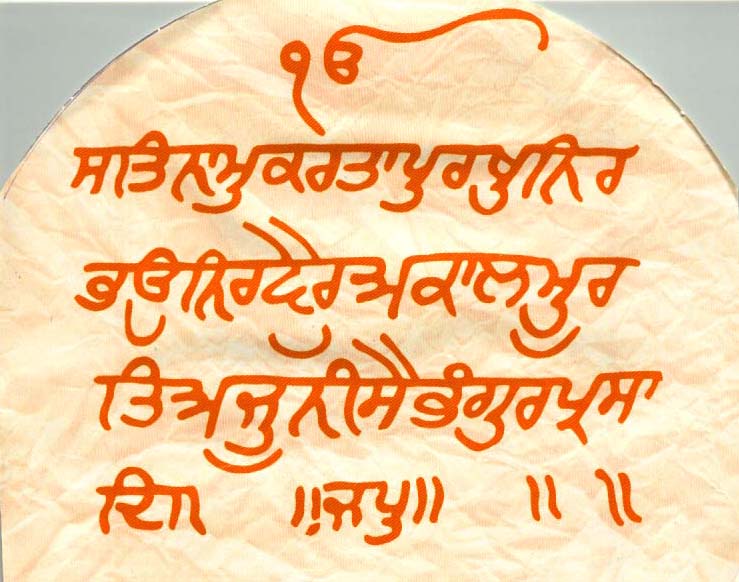
Mool Mantar is the most important composition contained within the Sri Guru Granth Sahib; it is the basis of Sikhism. It’s importance is emphasised by the fact that it is the first composition to appear in the holy Granth and that it appears before the commencement of most of the Raag section within this sacred volume.
Original Gurmukhi Text:
ੴ ਸਤਿ ਨਾਮੁ ਕਰਤਾ ਪੁਰਖੁ ਨਿਰਭਉ ਨਿਰਵੈਰੁ ਅਕਾਲ ਮੂਰਤਿ ਅਜੂਨੀ ਸੈਭੰ ਗੁਰ ਪ੍ਰਸਾਦਿ ॥... ॥ ![]() Play Audio
Play Audio
The Mool Mantar is said to be the first composition uttered by Guru Nanak Dev upon enlightenment at the age of about 30. Being the basis of Sikhism, it encapsulates the entire theology of this faith, and as a result, it is also the most difficult composition to fully understand.
The succeeding bani called the Japji Sahib and the rest of the sacred Granth totalling 1430 pages, are efforts to explain that which is contained within the Mool Mantar. .....More
Contents: Top 1. 10. 20. 30. 40. 50. 60. 70. 80. 90.
43
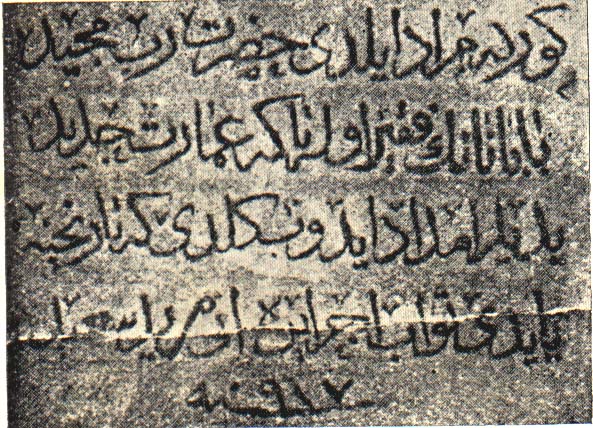
Guru Nanak in Baghdad Swami Ananda Acharya visited the shrine of Guru Nanak in Baghdad and wrote the following:
Upon this simple slab of granite did thou sit, discoursing of fraternal love and holy light, O Guru Nanak, Prince among India’s holy sons.
What song from the source of Seven Waters thou didst sing to charm the soul of Iran!
What place from Himalaya’s lonely caves and forests thou didst carry to the vinegroves and rose-gardens of Baghdad?
What light from Badrinath’s snowy peak thou didst bear to illumine the heart of Bahlol, thy saintly Persian disciple?
Eighty-four nights Bahlol hearkened to thy words of Life and the Path and Spring Eternal, while the moon waxed and waned in the pomegranate grove beside the grassy desert of the dead.
And after thou hast left him to return to thy beloved Bharat’s land, the fakir, it is said, would speak to none nor listen to the voice of man or angel; ....Continued
Contents: Top 1. 10. 20. 30. 40. 50. 60. 70. 80. 90.
44
Akal Takhat (Punjabi: ਅਕਾਲ ਤਖ਼ਤ) means the Throne of the Immortal and is historically the highest political institution of the Sikhs.
"Akal" means "The Timeless One" - another term for God. "Takhat" means "throne" in Persian. This is one of a total of five takhat of the Sikhs.
The Akal Takhat is an impressive building that sits directly in front of the causeway leading to the Golden Temple in Amritsar.
This institution was founded by Guru Hargobind on July 2, 1606 and was established as the place from which the spiritual and temporal (Miri Piri) concerns of the Sikh community could be acted upon.
It stood as a symbol of political bulwark against the Mughal Emperors in the 17th and 18th century. Various attacks on the Akal Takhat and Harmandar Sahib have taken place in the past by Ahmed Shah Abdali and Massa Rangar in the 18 century.
On June 4, 1984, the Indian Army damaged the outer façade of the Akal Takhat while attempting to flush out Sikh militants in a controversial military operation known as Operation Bluestar. .....More
Contents: Top 1. 10. 20. 30. 40. 50. 60. 70. 80. 90.
45

In his lifetime Guru Nanak, the founder of the Sikh religion travelled to distant places and one such place was Tibet.
The Guru is well respected by Tibetan Buddhists who consider him a saint; the Dalai Lama, spiritual leader of Buddhists in Tibet, has confirmed it in his discussions with some Sikh leaders that Tibetans revere Guru Nanak as a Buddhist saint under the name of Guru Gompka Maharaj.
According to the local legends of North Sikkim, some people approached the respected Guru with an appeal for help. The lake had remained frozen during most of the year and rendered it incapable as a source of water.
Guru Nanak Dev ji is said to have touched the lake with his foot, and it has never frozen since. Guru Nanak's footprints, a robe and a water-carrying utensil are preserved in a nearby place called Lachen Gompha. Here the locals refer to the Guru as Rimpoche Nanak Guru who on his way to Tibet had rested there. .....More
Contents: Top 1. 10. 20. 30. 40. 50. 60. 70. 80. 90.
46
Guru Nanak in Tibet In his lifetime Guru Nanak travelled to distant places and one such place was Tibet. Guru Nanak is well respected by Tibetan Buddhists who consider him a saint; The Dalai Lama, spiritual leader of Buddhists in Tibet, has confirmed it in his discussions with some Sikh leaders that Tibetans revere Guru Nanak as a Buddhist saint under the name of Guru Gompka Maharaj.
According to the local legends of North Sikkim, some people approached Guru Ji with an appeal for help. The lake had remained frozen during most of the year and rendered it incapable as a source of water. Guru Nanak Dev Ji is said to have touched the lake with his foot, and it has never frozen since. Guru Nanak's footprints, a robe and a water-carrying utensil are preserved in a nearby place called Lachen Gompha. Here the locals refer to Guru Ji as Rimpoche Nanak Guru who on his way to Tibet had rested there.
Some grazers projected another problem to Guru Nanak Ji. Due to the effect of altitude, their virility was affected. They requested the Guru to do something about it. Guru Nanak blessed the lake, saying, "Whosoever takes the water of this lake will gain virility and strength and will be blessed with children." The people of the area have firm faith in Guru's words and consider the water of the lake as nectar. A Gurdwara was constructed in eighties to commemorate Guru Nanak's visit to the place ....Continued
Contents: Top 1. 10. 20. 30. 40. 50. 60. 70. 80. 90.
47
Under a large papal tree, the priest pointed out a stone slab on which were carved two feet, laid with roses. “The Guru’s,” he said.
“It is at this spot that Guru Nanak sat in meditation. In that little shrine behind you, are buried the ashes of a Nepali king.”
We sat together on mossy steps leading up to the shrine, a strong scent of jasmine in the air and two bulbuls (passerine songbirds) pecking about the carved feet. And there he told me the story of the temple of the golden book and the shrine against which we sat.
It seems a Malla king of the early sixteenth century – the priest did not know his name – suffered a disturbed mind. His brothers, alarmed by his behaviour, banished him to India. Roaming forlornly through the holy city of Benaras he came upon the saint Guru Nanak and begged him to cure his affliction. After many visits and much beseeching, the guru advised the king to return to his kingdom where his health would be restored.
Miraculously, the saint preceded the king to Kathmandu for there he was, meditating under a papal tree on a hill beside the river. .....More
Contents: Top 1. 10. 20. 30. 40. 50. 60. 70. 80. 90.
48
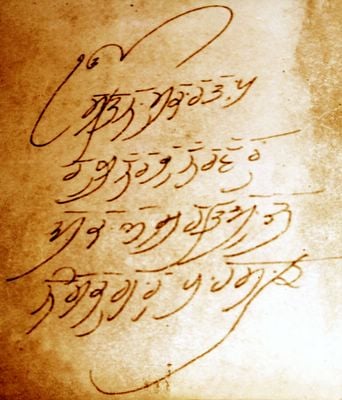
Japji sahib is the name given to the first bani (holy composition) to appear at the very beginning of the Sri Guru Granth Sahib from Page 1 to Page 8 of the sacred Granth (book) of the Sikhs.
The composition consists of the Mool Mantar (root mantar), a set of 38 Pauris (hymns) and a final Salok. Japji sahib is regarded as the most important bani or 'set of verses' by the Sikhs and is recited every morning by all practising faithful of this religion. The word ‘Jap’ means to ‘recite’ or ‘to ‘chant’. ‘ji’ is a word that is used to show respect as is the word ‘sahib’.
This Gurbani (words of the Guru) is said to be the condensation of the whole of the Sri Guru Granth Sahib and whoever recites this Bani with love, dedication and humility will have the complete blessing of Guru Nanak Dev. .....More
Contents: Top 1. 10. 20. 30. 40. 50. 60. 70. 80. 90.
49
Every year on 23rd July, the Sikhs celebrate the birthday of their eighth Guru, Guru Har Krishan - also fondly called "Bal Guru" ("Child Guru") as Guru ji attained Guruship at a young age of just over 5 years old. Each year during late July, huge celebrations are held at Gurdwara Bangla Sahib in Delhi, India to commemorate this auspicious day. It was at this location in Delhi where Guru ji stayed at Raja Jai Singh's bungalow during the reign of Mughal Emperor Aurangzeb.
Guru Har Krishan was born on July 7, 1656 at Kiratpur Sahib, Punjab, India and was the second son of Guru Har Rai and Mata Krishan Kaur Ji. When the Guru came to Delhi, he stayed at the bungalow of Raja Jai Singh. There was a severe smallpox epidemic and many thousands of people were dying. By Guru's blessing, the pool at Bangla Sahib, which is built at the site of Raja Jai Singh's bungalow provided cure for thousands of suffering people. Gurdwara Bangla Sahib is thus blessed by the healing powers of this eighth Sikh Guru. The tenth Sikh Guru, Guru Gobind Singh wrote in his famous "Vaar Sri Bhagauti Ji Ki" – "Remember Sri Harkrishan, whose vision dispels all pains". This shrine is not only visited by thousands of Sikhs but also people of other faiths. .....More
Contents: Top 1. 10. 20. 30. 40. 50. 60. 70. 80. 90.
50
On September 12, the Sikhs worldwide will remember with honor the supreme sacrifice of their brave comrades who for the security and safeguard of their country willingly laid down their lives. The bravery of these soldiers was inspired by the heart piercing message of their tenth Guru, Guru Gobind Singh.
O God, give me these boons
that never shall I shirk from doing good deeds
that never shall I fear when I go into battle
And that with surety I shall attain victory.
by Sri Guru Gobind Singh - the motto of the Sikh Regiment
Contents: Top 1. 10. 20. 30. 40. 50. 60. 70. 80. 90.
51
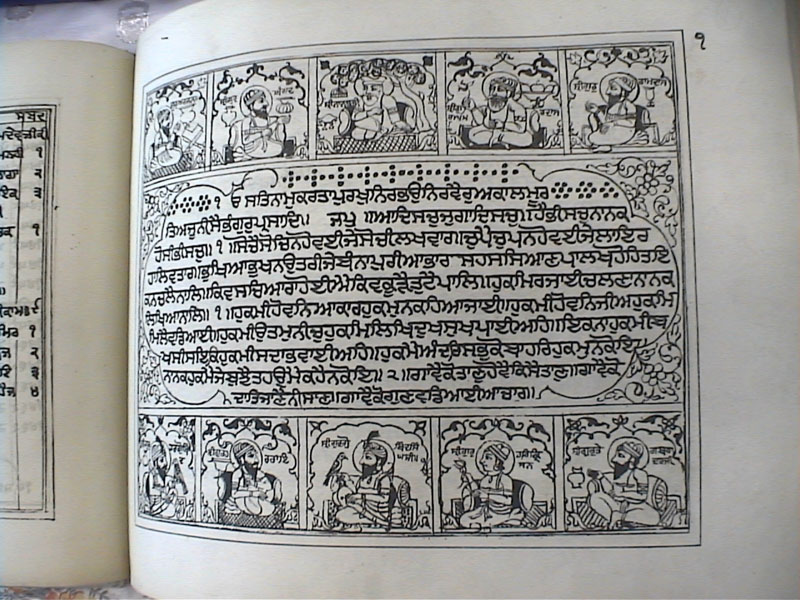
On September 1, 2004, the Sikhs celebrated the 400th year of the first installation of their holy scriptures called the Sri Guru Granth Sahib.
The Guru Granth Sahib was compiled and first installed at Harimandir Sahib (Golden Temple) in Amritsar in 1604. The holy book contains hymns written by the Sikh Gurus, saints and scholars of different religions and was completed on the 30 August 1604, it contains an important message for the whole of humanity.
The Guruship was passed to the holy Granth in 1708, some 104 year after its first installation in 1604. The holy Granth provides unique and unequalled guidance and advice for the whole of the human race. It is the torch that will lead humanity out of Kaljug, (the dark era) to life in peace, tranquillity and spiritual enlightenment for all the nations of the World.
"Guru Granth Sahib transcends creed and caste, cant and convention. It does not belong to the Sikhs alone. It consecrates the sayings of 11 Hindu bhakats and as many bard poets and seven Muslims, along with the teachings of six Sikh gurus. No other religion has included in its holy book the sayings of others, however revered." Quotation from Deccan Herald .....More
Contents: Top 1. 10. 20. 30. 40. 50. 60. 70. 80. 90.
52

Baba Deep Singh Shahid (26 January 1682 -13 November 1757): Every year on January 26, the global Sikh community celebrate the birthday of this courageous soldier of God.
He is one of the most honoured martyrs in Sikh history and the founder of the Shahid Misl as well as of the Damdami Taksal. He was a tall, strong, and uncommonly brave Sikh who was a bold and fearless saint-soldier, ever ready to risk his life for the Panth.
- At eighteen, he received Amrit at Anandpur sahib in the presence of Guru Gobind Singh ji.
- He spent about 8 years and learned Gurmukhi from Bhai Mani Singh along with horse riding, archery as well as other arms training.
- Met Guru Gobind Singh at Damdama sahib where Guru Ji asked him to start preaching Sikhism. Later became head "Granthi" at Damdama Sahib.
- Between 1705 and 1728, Baba Deep Singh and Bhai Mani Singh produced a number of hand written copies of the Guru Granth Sahib.
- Fought in various wars - In about 1709, Baba Deep Singh Ji joined Banda Singh Bahadur to fight in the battle of Sirhind .....More
53
Guru Angad Dev (1504 - 1552) was the second of the ten Gurus of Sikhism. Guru ji's original name was Bhai Lehna; Bhai sahib following in the footsteps of Guru Nanak, who was the first Sikh Guru and founder of the Sikh religion became the second Sikh spiritual master on September 18 1539.
Guru Angad Dev was born on April 18, 1504 and this auspicious day is doubly celebrated by the Sikhs every year together with the birthday of their ninth master, Guru Tegh Bahadur on this same day.
The institution of langar was given prominence and further maintained and developed during the Guruship of the second master. The Guru's wife, Mata Khivi personally worked in the kitchen to prepare the food and guide others in managing this important function of the Sikh panth (path). She also served food to the members of the community and visitors; her devotion to this institution finds mention in Guru Granth Sahib, the holy book of the Sikhs.
Guru Angad also invented the present form of the Gurmukhi script. It became the medium of writing the Punjabi language in which the hymns of the Gurus are expressed. This step had a far-reaching purpose and impact. Firstly, it gave the common people a language that was simple to learn and write. .....More
54
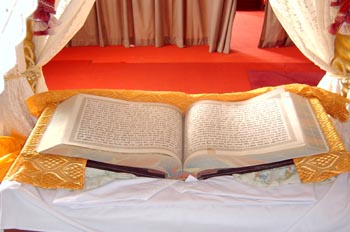
A peaceful, happy and contented life has become elusive for the modern man or woman!
Feelings of self worth, faith in the Omnipotent; unborn Creator; Saviour; kind, just Benefactor can be achieved by internalising the Guru’s word and hoping for His Grace.
Through His Hukam (command), His love and glory, the purpose of life becomes crystal clear and as a by-product, we start getting satisfaction in life; begin developing insights and start using tools of practical wisdom.
The Guru’s grace produces in human beings intensive elation, high level of well-being and higher and altered states of consciousness, awakened intelligence and re-appreciating of life through amazement.
Internalizing the Guru’s work makes a person return to humanity and humility. The Guru allows us to be free, to be ourselves, and to have worldly satisfaction, peace of mind and perpetual joy or (Anand). The Guru expects us to challenge the status quo, take risks, follow the righteous path by replacing the following five evil vices of the mind: kam, krodh, lobh, moh and ahankar .....More
55
In 2015, this week, from October 20, the worldwide Sikh community will celebrate 307 years of Guruship of their holy scriptures called the Sri Guru Granth Sahib.
In October 1708, the tenth and last human Sikh Guru, Guru Gobind Singh before setting off for his heavenly abode, installed the Granth Sahib as the final and perpetual Sikh Guru.
He said "Sabh Sikhan ko hukam hai, Guru maneo Granth" - "Every Sikh is ordered to accept the Granth as the Guru" and so from that day on, this Granth has served as the "living Guru" of the Sikhs.
The Sri Guru Granth Sahib was initially called the Adi Granth and was compiled and first installed at Harimandir Sahib in Amritsar in 1604. The holy book contains hymns written by saints and scholars of different religions and was completed on the 30 August 1604.
The SGGS contains an important message for the whole of humanity. The Guru Granth Sahib provides unique and unequalled guidance and advice for the whole of the human race. It is the torch that will lead humanity out of Kaljug, (the dark era) to a life in peace, tranquillity and spiritual enlightenment for all the nations of the World. .....More
Contents: Top 1. 10. 20. 30. 40. 50. 60. 70. 80. 90.
56
On 28 November every year, the Sikhs celebrate the birthday of the third son of Guru Gobind Singh, Sahibzada Zorawar Singh (28 November 1696 - 26 December 1705).
He was born to Mata Jito ji (also known as Mata Sundari ji) at Anandpur on this sacred day in 1696 and was barely nine years old at the time of the evacuation of Anandpur on the night of 5-6 December 1705.
Since the death of his mother, Mata Jito, on 5 December 1700, his grandmother Mata Gujari who had been especially attached to young Zorawar Singh and his infant brother, Fateh Singh took charge of both of them as the column moved out of Anandpur.
While crossing on horseback the rivulet Sirsa, then in flood, the three were separated from Guru Gobind Singh and the main party of Sikhs. .....More
57
Guru Amar Das (Gurmukhi: ਗੁਰੂ ਅਮਰ ਦਾਸ) (5 May 1479 - 1 September 1574) was the third of the ten Gurus of Sikhism; he became Guru on 16 April 1552.
Interestingly, he was aged of 73 when he was enthroned as Sikh Guru following in the footsteps of Sri Guru Angad Dev Sahib Ji, who left for his heavenly abode on 29 March 1552 aged 48.
Becoming a Sikh Guru at the age of 73 made Guru Amar Das ji the oldest person to attain Guruship.
Guru Ji was the eldest son of Sri Tej Bhan ji a farmer and trader and Mata Lachmi Ji, his devoted mother. He was a shopkeeper and lived in a village called Basarke which is near Amritsar.
The third Sikh Guru was married to Mata Mansa Devi and they had four children - Two sons named Bhai Mohan and Bhai Mohri and two daughters named Bibi Dani Ji and younger daughter named Bibi Bhani Ji. Bibi Bhani later married Bhai Jetha who became the fourth Sikh Guru, Guru Ram Das. See article Platforms of Jetha. .....More
58
Darshan is a Punjabi word which means "viewing" or "meeting". I woke up earlier than usual on darshan day.
The time must have been a little after midnight. Something seemed different that day. With difficulty I lifted my head and peeped out of the small window of my hut.
Although I could not see anything due to the pitch darkness of the night, I sensed some activity in the trees.
I closed my eyes and listened carefully. To my surprise I sensed the trees were in the same jovial mood as they were when spring was approaching. Winter had just started; it would be months before even the slightest hint of spring.
I lay down my head back on the pillow and realised that I too was in a jovial mood - my heart too hinted some hope and excitement. That was quite a change from the past few years of my miserable and painful existence. .....More
59
Bhai Lehna decided to stay with Guru Nanak at Kartarpur. However, Bhai Lehna’s companions left without him and continued their journey for Jawalamukhi to worship the goddess Durga.
After staying for a few days at Kartarpur, Bhai sahib said to himself, ‘Let me go to my village and tell my family and friends about my plans to stay with Guru Nanak. Then I shall come back and stay with the Guru for a longer period and no one will worry about my whereabouts.’'
Bhai sahib then went back to his village called Khadur Sahib in district Amritsar. He stayed at his village for a few days only but soon, he was ready to return to Kartarpur as he wanted to be with the Guru. He had enjoyed being in the company of the Guru and the Sangat; he wanted to learn from the Guru and to serve him and the community; this was the custom in those days. He wanted to become a disciple of Guru Nanak and learn true wisdom about life from him.
Before starting his journey back, he said to himself, ‘I must take something with me for the Guru. He runs a free kitchen. Scores of people take their meals from there. They do not have to pay anything for the meals. I should take something for the Langar or "free kitchen for all". But what should I take? Yes, let it be as heavy a load of salt as I can carry on my head.’ ....Continued. Contents: Top 1. 10. 20. 30. 40. 50. 60. 70. 80. 90.
60
After travelling through Arabia and many other countries, in 1521 A.D during the summer season, Guru Nanak reached a place called Hasan Abdal.
This place is about fifty kilometres from Rawalpindi in Pakistan to the west side of the mountains. This is hilly area and some places here have natural fountains which flow from the ground.
Guru ji with Bhai Mardana and a small party halted at this place at the foot of a hill. Under a shady cool tree, Guru Nanak and Bhai Mardana started reciting Kirtan as was their normal practise. Slowly, the local devotees began to gather around the Guru.
Soon, a large crowd of people began regularly to gather around the Guru. He talked to them about God and the true path of the holy. He told them about the greatness of God and His creations. More and more people began to gather around him every day.
On the top of the nearby hill, there lived a Muslim pir (priest). His name was Bawa Wali Qandhari. Wali Qandhari had established a celebrated dera (holy place) at this hill at Hasan Abdal, near a natural fountain. .....More
Contents: Top 1. 10. 20. 30. 40. 50. 60. 70. 80. 90.
61
On one of his mission to enlighten people, Guru Nanak Dev ji travelled many miles in the wilderness of Assam. When he rested close to the out-skirts of a small town, he heard something very distressing and painful. The local people who had gathered to listen to the Kirtan in the evening told Guru ji that there lived a tribe in the jungle of man-eaters. The tribe used to capture anyone who ventured into the forest. The people lived in constant fear from this tribe of cannibals. Many children and adults who had gone into the forest to collect fire-wood had never returned and were feared dead. The local expressed to Guru ji their concern that the cannibals had eaten their friends and relations who had not returned from the forest.
On hearing this the Guru became very sad and was lost in thought. He decided to act at once. Guru ji decided that he must meet these man-eaters and must make them give up this cruel way of life. He decided that he must end the misery of the town's people and free them from this constant fear of becoming victims of these merciless cannibals. .....More
Contents: Top 1. 10. 20. 30. 40. 50. 60. 70. 80. 90.
62
Guru Nanak and Bhai Mardana continued to travel to many different parts of the world. One day, they arrived at a beautiful location near Lahore, which is a historic city in present-day Pakistan.
The Guru decided to setup their camp outside the city. He sat on a green, grassy spot near the river Ravi. Sitting at this tranquil spot, the Guru fixed his thoughts on God and meditated for a little while.
Bhai Mardana began singing the Guru’s sacred songs or hymns called Shabads. At times, the Guru himself would join in and begin to sing Kirtan as well.
Soon, people who heard these simple but very heart rendering melodies began to gather around the Guru and Bhai Mardana. Folks everywhere loved to hear these sacred songs. They also liked to hear the Guru’s talks about life and the importance of meditation or Simran.
One day, during such a melodious recitals, a rich man of Lahore came to the Guru. He asked the Guru to go with him to his house.
The Guru said, "I am all right here. I am not really fond of grand houses. Moreover, my visit to your house might cause you inconvenience and unnecessary trouble." .....More
63
Guru Nanak Dev while on his eastward journey reached Haridwar. It is on the banks of the river Ganges and is one of the major centers for Hindu pilgrimage. The people, gathered there in large numbers, were bathing in the holy river. Guru Nanak Dev observed many people throwing water towards the sun in the east. The Guru had already heard about this meaningless ritual. He, therefore, thought it the right place and the proper time to give correct guidance that those kinds of mindless hollow rituals have no value.
These people who throwing handfuls of water from river Ganges, towards the sun in the east, believed that by this ritual they could offer water to their dead elders in the next world. This next world was in the East from where the Sun rose.
Guru Nanak Dev entered the river for purposes of bathing as other common pilgrims were doing. Instead of throwing water to the east, he, however, started throwing water in the opposite direction towards the west where Guru ji farm was. Taking him as a naive visitor, the nearby bathers told him that he was not performing the rituals correctly. They advised him to throw water to the east.
Guru ji continued throwing water towards the west pretending that he was very much absorbed in the 'holy' act and had not heard anything. Soon, many people gathered there to tell him that the proper method of performing the ritual was to throw water in the other direction. .....More
64
Sri Lehna was a pious man who lived in the village of Khadur near the town of Tarn Taran, in present-day district of Amritsar.
He was a good and honest man, whose skills and hard work as a shopkeeper had made him a very wealthy man. A Hindu he was a worshipper of the goddess Durga as were many other people of his village.
Every year he led a large group of his villagers on a pilgrimage to a famous temple of Durga in the foothills of the Himalayas called Jawalamukhi. He wore traditional bands of bells on his ankles and wrists dancing along the way singing bajans (songs) about the stories of the fabled tales of the battles of the goddess with mystical demons. Arriving at the temple he and many other bands of pilgrims would dance before the goddess with their bells tinkling when they danced about.
He had done this his whole life until one day as an old man he chanced to meet with another man in his village who was a Sikh, a follower of Guru Nanak. This man's name was Bhai Jodha. He was not a worshipper of Durga, as no Sikh worships any of the Hindu gods or goddesses. All Sikhs are worshippers of one God, commonly called "Waheguru". Bhai Jodha did not visit Durga’s temple. .....More
65
Bhagat Dhanna ji was a Sikh Bhagat who was born in about 1415, at village of Dhuan Kalan near Deoli city, in the Tonk district, Rajasthan, present day North West India. He was a simple Indian farmer. He worked hard on his farm all day tending his crops. He used to go past the house of this clever Pundit (priest) everyday on the way to his work on the farm.
Dhanna ji used to listen to the Pundit singing religions verses and carry out various ritualistic acts, which were beyond the understanding of this simple Jatt (farmer). He found these acts intriguing but never asked the religious man about any of the things that he had observed in the many years that he had gone past the Pundit’s house.
One day, Bhai Dhanna ji was passing the pundit's house and noticed that the religious man was feeding his Thakur - a stone idol. Bhai Dhanna ji was quite puzzled by what he was observing. On this occasion as he had some free time, he went and asked the Pundit,
"Pundit Ji, What are you doing?"
The Pundit was very hungry and wanted to get this feeding over as soon as possible and really wasn't in a mood for Bhai Dhanna ji's simple inquiries. He replied, "Oh, nothing, I am just feeding my Thakur. Now if you will excuse me..."
Bhai Dhanna ji found that incredibly funny, "What is the use of feeding a stone?" .....More
Contents: Top 1. 10. 20. 30. 40. 50. 60. 70. 80. 90.
66
Akbar was a famous king of India. He was a kind and good king and respected the Sikh Gurus for their sensible practises and their fair and just teachings. In the year 1569, Akbar came to the Punjab and wanted to see the Guru.
So he sent a message to Guru Amar Das ji that he was coming to visit him. The Sikhs were very happy at the news. Some Sikhs thought that special arrangements should be made to welcome the king.
But the Guru said, "Akbar is as much a human being as others are. The Guru's place is open to all. The king and his subjects, the Hindus and the Muslims, the rich and the poor are all equal here. So Akbar will be welcomed like all other visitors to the Guru's place and special arrangements need not be made."
- "Caste has no power in the next world; Only the humble are exalted there. It is only the good who are honoured for good acts." (Guru Nanak (SGGS p469))
The king, along with the Rajah of Haripur, arrived in Goindwal where the Guru lived. The Guru and a few Sikhs received them warmly. They were shown round the place. Akbar was interested to know how the Guru's Langar was run. Simple food was served to all in the Guru's Langar. It remained open day and night. .....More
67
During the times of Sher-e-Panjab, Maharaja Ranjit Singh, the Sikh Raaj (kingdom) stretched from the River Sutlej to Kabul (in Afghanistan). His key general was Sardar Hari Singh Nalwa, who was a Rehatvan (strictly observant) Sikh of the Guru.
Once, when Hari Singh Nalwa had set up camp with his army in Jamrud, in Afghanistan, a local Muslim woman called 'Bano' happened to watch the Sikhs set up camp. She found Hari Singh Nalwa very handsome and attractive, and had decided that he would be a good match and a fine man by which to have a son.
One day, Bano came to see Hari Singh Nalwa. He was sitting in his tent, when his guards told him that, there was a local woman who wished to see him. Not knowing who this lady was or what she wanted, Hari Singh gave permission for her to come in and see him. Bano said, "I have heard of the Sikhs. You are remarkable people. I have been watching you from a distance. I am not married and I have no children, but I desire to have a son who is like you."
Hari Singh, not understanding the motivation or intention of Bano, said, "May Waheguru bless you that you may have a son with the qualities of a Sikh." Bano irritably said, "I want to have a son with you Sardar Ji." .....More
68
Bhagat Beni also spelt as ‘’Baini’’ and ‘’Baynee’’ is one of the fifteen Sikh Bhagats and a Sufi saint who is believed to have been born in India. His Bani consisting of 3 shabads is included in the Guru Granth Sahib.
The place and year of his birth are unknown but Guru Nanak Dev refers to Bhagat Beni as "a Master of Yoga and meditation, and the spiritual wisdom of the Guru; He knows none other than God" (see last quote below - Guru Granth pg 1390)
In spite of all this uncertainty, he can be called a contemporary of Guru Nanak. It seems that Beni lived in this part of the world probably in northern India, somewhere between mid-15th century to the mid-16th century. He was a well educated scholar, with a very humble temperament. From his bani, it is clear that he was ever ready to serve the true preceptor which provided him real comfort in the manner depicted in the holy Granth: "O my Beloved, I have no one except You. Without You, nothing else pleases me. Loving You, I am at peace." SGGS-61
Bhagat Beni makes a severe denunciation of the Hindu rituals and austerities of "Hath Yoga" so that common man learns of the real motive of true religion i.e. the remembrance of the True Lord and the cultivation of the Divine Name. .....More
69
Once a king in India went to Guru Nanak Dev Ji and asked: "O Guru! As you told us, God Himself supports His true worshipper, but God has so many apostles, why does He support Himself? Why does He not send His apostles to help the worshipper?"
As he said this, his own son who was playing on the bank of a river nearby slipped into the river. The king did not wait for a second and jumped in the river as well to save his child.
After saving his child he returned to the Guru. The Guru asked: "My dear friend, you were sitting here with me a minute ago and why did you jump in the river?"
The king explained that his son had slipped into the river and he went to save him.
Then the Guru asked: "Dear friend, you have so many servants, why did you jump in the river yourself? Why did not you send your servants to save him?" .....More
Contents: Top 1. 10. 20. 30. 40. 50. 60. 70. 80. 90.
70
As the end of the year approaches, on December 26 every year, the global world Sikh community commemorate the martyrdom of three of their most beloved figures of the Guru household.
On this darkest of days, their youngest hero and bravest comrade of Sikhism, Sahibzada Fateh Singh (1699-1705) who was the youngest of Guru Gobind Singh's four sons, Sahibzada Zorawar Singh (1696-1705), his elder brother and Mata Gujari ji, his grandmother sacrificed their lives for their faith and the right to remain Sikhs.
Baba Fateh Singh with his elder brother, set a precedence in Sikh history (and perhaps also in world history) by becoming the youngest known martyrs to sacrifice their lives for their principles and the right to practice their religion and their faith without coercion or the threat of terror.
Even at such a tender age of just 6 years, Baba Fateh Singh showed courage, determination and free-will not to be intimidated by the cruel, barbaric and unjust authorities of the time. He showed composure, fearlessness and the renowned trait of unparalleled heroism becoming of the Sikh leadership and was prepared to sacrifice his life but not his faith. .....More
Contents: Top 1. 10. 20. 30. 40. 50. 60. 70. 80. 90.
71
Guru Nanak was born into a Hindu family. His father was called Mehta Kalu and his mother's name was Mata Tripta. He worked for a Muslim as he grew up so he learned about the Muslim religion too. Eventually he became a religious teacher, teaching about a new faith using ideas from both Hinduism and Islam. This new religion, called Sikhism, was based on one God, on the equality of all human beings and always doing good deeds. Nanak travelled far and wide to teach about the new religion, he wrote hymns about his beliefs. He became known as a "Guru". His most famous hymn is the Japji, which Sikhs say at dawn each day. .....More
Contents: Top 1. 10. 20. 30. 40. 50. 60. 70. 80. 90.
72
The word Sikh means "student" or "disciple" in the Punjabi language. Sikhs are students and followers of Guru Nanak (born 1469), the founder of the Sikh tradition. Guru Nanak was succeeded by nine Gurus or holy teachers.
Since 1708, the Sikh Guru has been their religious scripture, the Guru Granth Sahib. Sikhism is the youngest of the world's major religions, being founded in the 15th Century. (Guru Nanak, their first 'spiritual teacher' or Guru was born in 1469)
There are over 23 million Sikhs worldwide, making Sikhism the fifth largest organized religion in the world. There are about 800,000 Sikhs in the United Kingdom and about 1,200,000 Sikhs in North America. Almost 18 million Sikhs live in the Punjab district in what is now India and Pakistan.
Sikhism teaches that there is one God, all people are equal and good actions are important for a Sikh. Sikhs also believe in honesty, truthfulness, charity, and the constant remembrance of God. They consider that empty religious ceremonies have no real meaning in life. Consequently they avoid pilgrimages, fasting and statue worship. .....More
Contents: Top 1. 10. 20. 30. 40. 50. 60. 70. 80. 90.
73
The following is a brief summary of the conduct expected from a Sikh of the Guru. Full instructions for the Sikh are given in the Sri Guru Granth Sahib which is more than a holy book for the Sikhs - It is their "Living Guru". By reading the Guru Granth Sahib, the Sikh can learn about the Sikh beliefs and the type of conduct expected from a Sikh.
An online text with English translation of the Sri Guru Granth Sahib can be found here.
Instructions
- 1. There is only one God; worship and pray only to Him (Simran).
- 2. Always remember the one God (Naam Japo), work hard and honestly (Kirat Karni), and share with others (Wand kay Shako).
- 3. At all times practice Truth, live a Truthful life and engage in service (Sewa) for the community.
- 4. Remember that women are as good as men and must be treated as equals.
- 5. Always remember the whole of the human race is one. Distinctions on caste, colour and class are wrong and against Sikh principles. .....More
Contents: Top 1. 10. 20. 30. 40. 50. 60. 70. 80. 90.
74
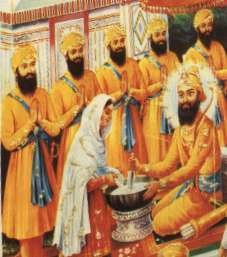
Every year in April, the whole of Punjab in northern India had been celebrating the New year on Vaisakhi day with great fanfare and wild fairs and festivities.
This was the main Sikh festivals and traditionally it was the end of the wheat harvest. But in 1699, this festival became extra special because it was chosen by Guru Gobind Singh as the day to start the Khalsa fellowship.
On April 13th in most Sikh Gurdwaras a special ceremony takes place as a reminder of this special first Amrit Ceremony.
This first Amrit Ceremony took place in India on April 13, 1699 when Guru Gobind Singh asked a gathering of Sikhs who was prepared to die for God or Waheguru. At first there was a hesitation then one man stepped forward...The Guru and he went together into the tent. Then, Guru Gobind Singh reappeared on his own with blood dripping from his sword. He asked again, and again, again and again. Four brave Sikhs answered the Guru's call for a head. The Guru took the fifth man into the tent and then there was a delay. .....More
Contents: Top 1. 10. 20. 30. 40. 50. 60. 70. 80. 90.
75
Every important Sikh ceremony is performed in the presence of the holy Guru Granth Sahib. The ceremonies which are most important to a Sikh are:
Baptism or Amrit Ceremony
Marriage or Anand Karaj
The Death Ceremony Antim Sanskar
Naming Ceremony – Naam Karan:- Sikhs name their children only after they are born, as it is customary to bring the child into the presence of the Holy Granth as soon as it is convenient and when the mother is well enough to go to the Gurdwara. The Holy Granth is opened at random and a verse (Shabad) from the pages opened is read. The first letter of the first word of the 'Shabad' (hymn) on the page is chosen as the initial letter of the child's name. Now this could be any letter of the alphabet. For example if the first letter is 'S' then any name such as Surinder, Surjit, Sukhdev, Satnam, Sarabjit, Satwant, Sukhwinder, etc could be chosen by the parents to their liking. See Sikh Names to see over a thousand Sikh names. .....More
Contents: Top 1. 10. 20. 30. 40. 50. 60. 70. 80. 90.
76
Guru Granth Sahib ji:- is more than just the Sikh Holy book; it is respected by the Sikhs as a "perpetual Guru" or "Ever-present guide". If it is not in use it is wrapped in decorative silks and richly embroidered cloths and placed on a platform.
Before his death in 1708, Guru Gobind Singh, the 10th Guru ordained that from then on the sacred "Granth" (holy Book) should be recognised as the manifest body of the Gurus - and hence the name Guru Granth Sahib Ji. It was first compiled by Guru Arjan in 1604 and was then known as the "Adi Granth" or "first Book".
During the day the book is opened and placed on a small dais called the Manji Sahib with a canopy above and rests on several cushions. If it is not being read it may be covered with a cloth called a Rumalla. Whilst it is being read a fan called a Chaur Sahib may be waved over it to show sign of respect and honor for the holy message. Sikhs usually place an offering in cash or kind or both as they approach the holy Granth, and bow down low on their knees to show their respect for its message. During a religious service, a 'Granthi' (one who reads the Granth) or a sewadar (volunteer) remains in constant attendance and holds a Chaur (a symbolic whisk of sovereignty) which he occasionally moves over the Granth. ... Continued.
Contents: Top 1. 10. 20. 30. 40. 50. 60. 70. 80. 90.
77
Sikhism was founded in the early fifteenth century by their founder and spiritual teacher called Guru Nanak. He was firmly of the belief that all people were born equal and should have equal opportunities.
Guru means "spiritual leader" and he guided his people in the way of God's will or Hukam believing there was only one universal God and that we were all accountable to Him. There are over 25 million Sikhs worldwide and the religion is open to anyone.
Guru Nanak was born in the village of Talwandi, now called Nankana Sahib, near Lahore in present-day Pakistan. His parents were of Hindu background and he was from a family who were traders.
Even as a boy, Nanak was fascinated by religion, and his desire to explore the mysteries of life eventually led him to leave home and he travelled all over the world in the manner of Indian saints. It was during this period that Nanak met many religious people and preached his message of one God to all the people of Central Asia. He made five distinct major journeys, which are called Udasis spanning many thousands of miles covering most of Central Asia and the Middle-East. .....More
Contents: Top 1. 10. 20. 30. 40. 50. 60. 70. 80. 90.
78
A cousin of Guru Ram Das came to Amritsar from Lahore especially to ask the Guru to attend his son's wedding.
The Guru said, "I will not be able to go because I can't leave my duties as Guru. Perhaps I can send one of my sons instead."
Guru Ram Das had three sons: Prithi Chand, called Prithia, Mahadev, and Arjan Mal. Prithia was in charge of collecting donations, of which he secretly took a portion for himself. When the Guru asked him to attend the wedding, Prithia said, "I have to take care of the collections. And I hate going to weddings."
Actually, he was afraid if he were away from the Guru for too long, he might not be appointed the Guru's successor. Having no luck with Prithia, the Guru then turned to Mahadev. Mahadev lived his life in meditation and said, "I have no desire to involve myself in worldly affairs."
Finally, the Guru asked Arjan if he would go. Arjan said, "I only desire to do what you wish." The Guru was very pleased. He asked Arjan to spend some time in Lahore to share the Guru's teachings with the city's inhabitants and Sikhs. Any donations he received were to be given to the free kitchen to feed the poor. The last words he said to Arjan were, "You should stay in Lahore until I send for you by letter." .....More
Contents: Top 1. 10. 20. 30. 40. 50. 60. 70. 80. 90.
79
Dances of Punjab
Punjab is a very rich state in terms of the types and number of folk dances that can be found here. It has many different varieties of folk dances, among which the most famous and popular are Bhangra and Giddha. These days, not to miss out of a good thing, many non-Punjabis are also getting into the spirit and fun of Punjab's folk dance, as you occasionally see a European, African or Chinese face in various Bhangra competitions. These non-Punjabis have simply made Punjabi dance a part of their own local culture.
The exuberance and vitality of the people of Punjab are vigorously displayed in their folk dances. The moves are full of expression, gestures, vocal remarks, subtleties of motion and uninhibited freedom – it is a dance from the heart! With the drum beat or to the tune of some other instrument of folk music, the energetic feet of the people of Punjab are spontaneously set to give in to inhibition and give instant birth to a folk dance - an expression of the triumphant soul; an outburst of emotions; a sudden release of energy. The dances of Punjab are the clear depiction of the energy and enthusiasm of the lively youth of Punjab. Punjab's folk dances are replete with foreign influences. It is only in Punjab where there is no common dance for men and women. ...Continued
(Main contributor to this series: Harpreet Singh, Mohali, Punjab)
Contents: Top 1. 10. 20. 30. 40. 50. 60. 70. 80. 90.
80
Guru Nanak Udasis
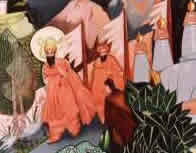
Painting by Ravi Bhangu
Guru Nanak saw the world suffering because of hatred, fanaticism, falsehood and hypocrisy. The people of the world were lost and doomed due to their wickedness and sin. So he decided that he had to travel, educate and press home the message of Almighty Lord so that these poor people would understand the true and pure message of the Lord.
So he set out in 1499 on his mission for the regeneration of humanity on this earth. He carried the torch of truth, heavenly love, peace and joy for mankind. For 1 year he spread his message of peace, compassion, righteousness and truth to the people in and around his home town.
Then in 1500, he embarked on his Divine Mission and went thousands of miles towards the east, west, north and south and visited various centers of Hindus, Muslims, Buddhists, Jainis, Sufis, Yogis and Sidhas. He met people of different religions, tribes, cultures and races. He travelled on foot with his Muslim companion named Bhai Mardana, a minstrel.
His travels are called Udasis. On his first Udasi (travel), Guru Nanak covered the eastern part of India and returned home after spending about 6 years spread the message of Waheguru. .....More
Contents: Top 1. 10. 20. 30. 40. 50. 60. 70. 80. 90.
81
In December 2004, while I was studying in London, I visited the Gurdwara Sahib in Southall and Giani jee was doing Katha (discourse on Gurbani). Giani jee's words stuck in my mind. He explained how Gurbani says, "Waheguru resides WITHIN ALL and that Waheguru FORGIVES and CLEANS the sins or filth of a sinner."
He went on to explain how at the end of Ardas we all say together, "naanak naam chardee kalaa, tere bhaane sarbat da bhalaa". Yes, we say, ‘SARBAT DA BHALAA’. We ask for the blessing of ‘ALL’. Guru Gobind Singh Sahib did NOT say, "I ask for the good of all EXCEPT for AURANGZEB who cowardly murdered my two young sons." No. When we do Ardas we do not say, "Sarbat Da Bhalaa, but NOT that person who swore at me last week… I don’t want his bhalaa (good)."
A beautiful analogy was given to illustrate that there is good within all. We say Waheguru is within all, but from personal experience seeing Waheguru in everybody is difficult at times. .....More
Contents: Top 1. 10. 20. 30. 40. 50. 60. 70. 80. 90.
82
Free-for-all is a term generally used to describe chaos. And chaos is a word one could use to describe much of Delhi.
But at the Gurdwara Bangla Sahib kitchen, a Sikh temple which serves meals to around 10,000 people every single day, there's not a trace of chaos. And the food is free for all.
This week, Alex and I are at the Doors of Perception conference in India, where the theme is "Food and Juice." It's an exploration of food systems worldwide, and the energy required to make them go.
On the first full day of the conference, the fifty-odd attendees split into small groups to go exploring the city of Delhi through its food culture. A number of groups focused on the prolific street vendor network, several looked at Delhi's water, and my group of nine went to Gurdwara Bangla Sahib to see how they achieve the daunting task of feeding thousands of people in single a day. .....More
Contents: Top 1. 10. 20. 30. 40. 50. 60. 70. 80. 90.
83
Structure of Guru Granth Sahib
The Guru Granth Sahib begins with the word "Ek Onkar" – The All Pervading Being. From this Word to the tenth Word “Gur-parshad” is called the Mool Mantra. After this is the rest of the composition called the Japji composed by Guru Nanak Dev. This comprises 38 Pauris or stanzas, a Prologue and an Epilogue. This is one of the morning prayer of the Sikhs.
The next composition has two parts - (1) "So Dar" and (2) "So Purkh". The Bani, "So Dar" contains 5 Shabads and "So Purkh" contains 4 Shabads. This form most of the evening prayer of the Sikhs and is called the Rehras. After this is the Bani called Sohila (full name, Kirtan Sohila), which contains 5 Shabads and is the bed-time prayer.
Within it's 1430 pages, most of the Shabads (hymns) of the Sri Guru Granth Sahib are arranged in thirty-one Ragas, the traditional Indian musical measures and scales. ....Continued.
Contents: Top 1. 10. 20. 30. 40. 50. 60. 70. 80. 90.
84
Sikhism and the Environment
"The Lord infused His Light into the dust, and created the world, the universe. The sky, the earth, the trees, and the water - all are the Creation of the Lord. ||1||" SGGS page 723
The Sikh scripture, Guru Granth Sahib, declares that the purpose of human beings is to achieve a blissful state and to be in harmony with the earth and all of God's creation. It seems, however, that humans have drifted away from that ideal. For the earth is today saturated with problems. It is agonizing over the fate of its inhabitants and their future! It is in peril as never before. Its lakes and rivers are being choked, killing its marine life. Its forests are being denuded. A smoky haze envelops the cities of the world. Human beings are exploiting their fellow human beings.
The Sikh Gurus showed the world the way to live in harmony with the environment and all their communities were developed in adherence to this principle. Guru Har Rai, the seventh Sikh Guru developed Kiratpur Sahib as a town of parks and gardens. " ....Continued.
Contents: Top 1. 10. 20. 30. 40. 50. 60. 70. 80. 90.
85
Jallianwala Bagh Massacre, involved the killing of hundreds of unarmed, defenceless Indians by a senior British military officer. The incident took place on 13 April 1919 in the heart of Amritsar, the holiest city of the Sikhs, on a day sacred to them called Vaisakhi - the birth anniversary of the Khalsa.
Jallianvala Bagh, a garden belonging to the Jalla, derives its name from the owners of this piece of land in olden times. At the time of this incident, this land belonged to the family of Sardar Himmat Singh Jallevalia (d.1829), a noble in the court of Maharaja Ranjit Singh (1780-1839), who originally came from the village of Jalla, now in Fatehgarh Sahib district of the Punjab.
The family were collectively known as Jallhevale or simply Jallhe or Jalle, although their principal seat later became Alavarpur in Jallandhar district. The site, once a garden or garden house, was in 1919 an uneven and unoccupied space, an irregular quadrangle, indifferently walled, approximately 225 x 180 metres which was used more as a dumping ground rather than a garden.
In the Punjab, during World War I (1914-18), there was considerable unrest particularly among the Sikhs, first on account of the demolition of a boundary wall of Gurdwara Rakab Ganj at New Delhi and later because of the activities and trials of the Ghadrites almost all of whom were Sikhs. .....More
Contents: Top 1. 10. 20. 30. 40. 50. 60. 70. 80. 90.
86
Sahibzada Jujhar Singh (27 September 1691 - 7 December 1705), the second son of Guru Gobind Singh, was born to Mata Jito ji (also known as Mata Sundari ji) at Anandpur on 27 September 1691 (as per Nanakshahi calendar).
Like his elder brother, Ajit Singh, he started training in the fighting skills (Gatka) as soon as he started learning the religious texts aged about 4 to 5 years. In 1699, when he was eight years old, he received holy Amrit at the rites of Khalsa initiation, called Amrit Sanskar.
By the time it became necessary to leave Anandpur under the pressure of a besieging host in December 1705, Jujhar Singh, nearing the completion of his fifteenth year, was an experienced young warrior, strong and fearless.
He was one of the band that successfully waded through the flooded Sarsa rivulet on horseback .....More +
Contents: Top 1. 10. 20. 30. 40. 50. 60. 70. 80. 90.
87
For many 1000's of years, April has been the time when farmers have put their sickles to harvest and collected the precious life saving crops.
In the countryside, during this time, the fragrance of the harvest is ubiquitous with scenes of many large piles of grains in one corner of the field; the stacks of wheat stalks ready as fodder for the cattle in another and the general urgency and excitement of the hustle and bustle of transporting and selling of the farm commodity by the farmers.
Without a good harvest, communities would perish and so there was always great joy when a good harvest resulted at Vaisakhi time. Spring season has always been an important and decisive time for the people of the northern hemisphere from times immemorial. During historical times, much had depended on the outcome of the harvest.
However, since 1699, the Sikhs have had a further reason to celebrated at this time of the year. Now Vaisakhi is celebrated with even more energy, pomp and fanfare. It has become a holy day to mark the birth of the Khalsa fraternity. And so 300 years on, this traditions continues with much gaiety, vigour and enthusiasm. Sikhs worldwide will justifiable spend much time remembering this most important day in their religious calendar – the day the Khalsa was created. .....More
Contents: Top 1. 10. 20. 30. 40. 50. 60. 70. 80. 90.
88
The Knight Riders
They come galloping on horse-back with lances in their hands, pick up a wooden peg and pass off in a whiff, leaving you marvelling at the sort of stuff these young guns are made of.
The scene is no take from a cavalry strike - they are the riders, regal and fearless, of sadda Punjab, where equestrian sport has just arrived in a big way, moving away from the confines of police and military equestrian academies. Be it the swanky Chandigarh Horse Riding Society next to the picturesque Sukhna Lake or the Punjab Public School Riding Academy in the princely town of Nabha, young boys and girls are taking to this royal sport passionately, like never before.
Not to be left behind are equestrian academies of Kirpal Sagar Academy in Punjab's hinterland (Nawanshahr) and the Shivalik Riding and Pony Club at Chandimandir, headquarters of the western command.
Each of the academies are providing riding opportunities to explore the centuries old bond between man and horse which kept improving considerably as the role of the horse kept changing. ...Continued
Contents: Top 1. 10. 20. 30. 40. 50. 60. 70. 80. 90.
89
Hazrat Mian Mir was a famous Muslim Sufi saint who lived in Lahore. He was born at Sevastan (Sindh) in 1531 AD.
Due to the high esteem and great respect for the Sufi saint, the fifth Sikh Guru, Guru Arjun Dev asked Mian Mir to lay down the foundation stone of Harmandir Sahib, the main Sikh shrine in the world.
The ceremony duly took place on 3rd January 1588 AD, when Sai ji laid down the foundation stone at Amritsar over 420 years ago. Thus began the history of the most famous Sikh shrine and the occasion crystallised the very important message of true interfaith respect and close dialogue among the different peoples of faith in the world.
Guru Arjan Dev was responsible for the construction of many tanks and buildings in Punjab. In 1588, he planned to build an impressive temple in the centre of the holy tank called Amritsar or the pool of nectar. As the temple was to be thrown open to people of all castes, creeds and climes, he invited Mian Mir who was a close friend of the Guru to lay the foundation stone of this shrine. .....More
Contents: Top 1. 10. 20. 30. 40. 50. 60. 70. 80. 90.
90
In December 1634, Guru Hargobind Sahib fought a fierce battle against Mughal forces near the river Beas. Although heavily outnumbered, the Guru was victorious.
Guru Sahib decided to stay at this location for a while, and soon a settlement grew up at the site. The settlement expanded into a town which became known as Sri Hargobindpur. As the ongoing conflict with the Mughals was intensifying the town's defences were fortified.
In fact, these fortifications were so solid that the original city walls and many buildings within are still visible today throughout Sri Hargobindpur in Gurdaspur district, Punjab.
Residents of all faiths flocked to the Guru and perceived themselves as heirs to the sixth Guru’s desire to found a secure and secular home on the banks of the Beas. The Sikhs built themselves a Gurdwara but the few local Muslims did not have the capacity to build themselves a place of worship.
So they came to the Guru and asked him for help. The All-Knowing Guru was equally comfortable with Muslim faqirs and Hindu sadhus and saw all people with one benevolent gaze. The Guru ordered his Sikhs to start construction of a mosque or "Masjid". The Masjid was duly completed and turned over to the Muslims. .....More
Contents: Top 1. 10. 20. 30. 40. 50. 60. 70. 80. 90.
91
Mata Gujri (1624 -1705) (whose formal name was 'Mata Gujar Kaur') was the wife of the ninth Sikh Guru, Guru Tegh Bahadur; the mother of the tenth and last human Sikh Guru, Guru Gobind Singh and the grandmother of the four Sahibzade.
She was born in 1624 and was the daughter of Bhai Lal Chand Subulikka and Bishan Kaur, a pious couple of Kartarpur, in present-day Kapurthala district of the Punjab. Her role in the development of the Sikh faith has been crucial.
She was the wife of a supreme martyr; mother of a brave saint-soldier; and the grand-mother of four amazing children who all attained martyrdom at the ages of 6, 9, 14 and 18 years. She had been close to the two younger sahibzade and took up their guardianship in the flight from Anandpur under a promise of safe passage to Punjab. Imprisoned in the Thanda Burj of Sirhind with her youngest grandsons Zorawar and Fateh Singh, she attained martyrdom, at the age of 81 years, when she was told of their execution. .....More
Contents: Top 1. 10. 20. 30. 40. 50. 60. 70. 80. 90.
92
Panj Piare (literally means the "five beloved ones") and is the name given to the five Sikhs, Bhai Daya Singh, Bhai Dharam Singh, Bhai Himmat Singh, Bhai Mukham Singh and Bhai Sahib Singh, who were so designated by Guru Gobind Singh at the historic divan at Anandpur Sahib on 30 March 1699 (now celebrated on April 14).
They formed the nucleus of the Khalsa as the first batch to receive at the Guru's hands khanda di Pahul, i.e. rites of the two-edged sword. Today, the term is used to refer to the five who perform this same rites of baptism for the Khalsa panth.
In Sikh theology, as in the Indian classical tradition generally, panj or panch, the numeral five, has a special significance. Guru Nanak in Japji refers to five khands, i.e. stages or steps in spiritual development, and calls a spiritually awakened person a panch. The ancient Indian socio-political institution "panchayat" meant a council of five elders. Something like an inner council of five existed even in the time of the earlier Gurus: five Sikhs accompanied Guru Arjan on his last journey to Lahore; the five were each given 100 armed Sikhs to command by his successor, Guru Hargobind; Guru Tegh Bahadur, set out on his journey to Delhi to court execution attended by five Sikhs. .....More
Contents: Top 1. 10. 20. 30. 40. 50. 60. 70. 80. 90.
93
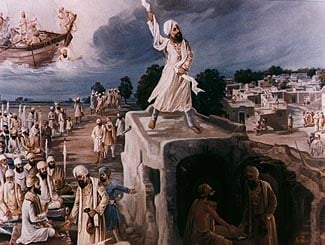
Lobanas are a community of Sikhs who played an important role during the times of the Sikh Gurus. Several key incidents in the times of the ninth and tenth Gurus are attributed to this Sikh community.
Baba Makhan Shah was a devout Sikh and was responsible for finding the ninth Sikh Guru, Guru Tegh Bahadur and Lakhi Shah Vanjara was responsible for cremating the body of ninth Guru in his own house. Lobanas also fought many wars with Guru Gobind Singh and Baba Banda Singh Bahadur.
Lobanas are a tribe who live all over India. Labanas have their own language called "Lubanki" which is a dialect. However, this language is only spoken by Labanas outside the Punjab, state of [[India[[. The Labanas of Punjab and Haryana are mostly Sikhs and speak mainly Punjabi or Hindi.
The term Lobana appears to have been derived from LUN ("salt") and the BANA ("trade"). The Lobanas were the great salt-carrying and salt-trading community. They were occasionally called "Banjaras". In Punjab, they were known by several different names. In Ambala district, for example, on account of their versatility in adopting different vocations, the Lobanas were called "Bahrupias" .....More
Contents: Top 1. 10. 20. 30. 40. 50. 60. 70. 80. 90.
94
The tercentenary celebration of the Guruship of Sri Guru Granth Sahib is to be undertaken in a massive event next year in October 2008 at Takhat Sachkhand Shri Hazur Abchalnagar Sahib in Nanded, Maharashtra, India. The main Sikh Gurdwara situated in Nanded and the surrounding areas are undergoing a huge rebuilding exercise to facilitate the large inflow of pilgrims for this rare, hugely important and once-in-a-lifetime occasion for the Sikhs and also for the whole of the world.
This event is of great relevance to the worldwide Sikh Community and will involve the remembrance of the 300th years of consecration of Guru Granth Sahib as the final and perpetual Guru of Sikhs as ordained by Guru Gobind Singh in 1708. The event will also commemorate the 300th anniversary of the accession of Guru Gobind Singh to his heavenly abode. The Guru Granth Sahib is regarded as the guiding light for the Sikh and many non-Sikhs also have tremendous respect for the teachings contained within the pages of this holy scripture. On this momentous occasion, both non-Sikhs and Sikhs alike will join hands in millions to honor the high principles of peace, equality, unity, forgiveness and the many other high and noble messages promoted by the Guru.
The main celebrations at Nanded will be over 8 days and will be conducted in the month of October 2008. It is estimated that this event will attract 2,500,000 to 3,000,000 visitors from all over the world during the last three months of 2008. Many new facilities are being built and the State Government has great plans for this event.
- See this site for the latest information: Official State Government Website for the Event
- Also read more at Hazoor Sahib and Guru Granth Sahib
Contents: Top 1. 10. 20. 30. 40. 50. 60. 70. 80. 90.
95
Damdami Taksaal
The Damdami Taksaal is the travelling Sikh university, which was founded by Guru Gobind Singh, the tenth Sikh Guru in about 1705 to impart knowledge of Gurmat onto all the people of the world.
It has had an unbroken lineage of Jathedars (leaders) who have led the Taksal throughout Sikh history from the time of the tenth Patshah (king).
The first and foremost function of the Taksal is to educate Sikhs, to teach them the correct pronunciations of Gurbani, to do Katha and Kirtan. This is done by getting students to undergo rigorous studies, Simran (meditation) and seva (selfless service), thus a wholesome Sikh lifestyle is developed and maintained.
The Taksal has always been a key strategic player in the activities of the Sikh Nation, with Baba Deep Singh & Baba Gurbaksh Singh (respectively 1st & 2nd Jathedars) both being martyred defending the sanctity of Sri Harimander Sahib, Amritsar, they were both beheaded yet still fought on until the Mughals had to run in fear.
The sixth Jatheder, Giani Bhai Sant Singh was the Head Granthi of Sri Harimander Sahib and a close aid of Maharaja Ranjit Singh. The famous Sikh Historian Bhai Santokh Singh (author of Suraj Parkash) was also a student of the Giani Bhai Sant Singh Jee. .....More
Contents: Top 1. 10. 20. 30. 40. 50. 60. 70. 80. 90.
96
Interfaith Dialogue
An important Interfaith Conference was held recently at a Sikh Gurdwara in Birmingham, UK. The conference which was hosted by Bhai Sahib Mohinder Singh, Chairman of Guru Nanak Nishkam Sewak Jatha was held over three days from 12 to 14 February 2007. At this prestigious meeting, discussions about delicate issues pertaining to the current volatile world environment took place. The assembly looked at the situation facing Muslims in Britain through four focused presentations; “Muslims in Britain, what’s the problem”, “terror and fear”, “religion and education” and “religion and the public sphere” – issues of major importance to Europeans and others all over the world.
Before the formalities began, nearly 30 prominent religious leaders from Europe toured the Gurdwara, first visiting the Darbar Hall where prayers were said for the success of the delegation's noble mission which was about to commence. Following this, the delegation, as per the custom in the house of Guru Nanak partook Langar, many for the first time. The council members were impressed with the warmth and hospitality of the Gurdwara Sevadars.
"Global religious tensions should be tackled at a local level", an MP said in Birmingham today. John Battle, the Prime Minister’s faith envoy, said that "the religious challenges facing the world were now evident in neighbourhoods across the UK." …Continued
Contents: Top 1. 10. 20. 30. 40. 50. 60. 70. 80. 90.
97
Nankana Sahib is named after Guru Nanak (1469-1539), the founder of the Sikh faith. Guru Nanak was born here on Baisakh sudi 3, 1526 Bk/ 15 April 1469.
Nankana town is part of Nankana Sahib District in the Punjab province of Pakistan. This district is adjacent to Sheikhupura district and until 2005 was part of this district.
The old name of this town was Talvandi Rai Bhoe Ki or "Talvandi of Rai Bhoe", a Muslim Rajput of the Bhatti clan and a retainer of the Delhi rulers of the early fifteenth century.
His descendant, Rai Bular, the chief of Talvandi, was a contemporary of Guru Nanak. The town has nine gurdwaras including the Gurdwara Janam Asthan which marks the birth place of Guru Nanak Dev.
The first 15 or 16 years of Guru Nanak's life were spent at Talvandi. Later, he shifted to Sultanpur Lodhi, in present day Kapurthala district of the Punjab, where his sister Bibi Nanaki lived. From there he set out on his long preaching odysseys, visiting his parents at Talvandi only now and then, his last visit to his native place being in 1510. Several shrines in the town, raised long after his death, mark the places where he was born, where he played with other children, where he studied and where he tended his father's cattle. .....More
Contents: Top 1. 10. 20. 30. 40. 50. 60. 70. 80. 90.
98
Most of us think that Sikh or South Asian migration to Australia is a recent phenomenon, spanning just the past few decades.
But not many of us know that our Sikh forefathers first came to Australia more than 150 years ago - at a time when the dust was yet to settle from the fall of Ranjit Singh's empire.
Displaying their true enterprising spirit, they crossed the seven seas to come to the land Down Under, in search of a better lifestyle and wages, and quickly endeared themselves to the local population here.
Country towns all over Australia are dotted with memories of these brave Punjabi migrants, who seem to have been welcomed by the locals despite the official "White Australia" policy.
Sadly, they are also forgotten in the annals of history. Initially, the migrants from India were indentured labourers, who worked on sheep stations and farms around Australia. Some adventurers followed during the gold rush of the 1850's. .....More
Contents: Top 1. 10. 20. 30. 40. 50. 60. 70. 80. 90.
99
H a p p y · Birthday
|
||
t o
| ||
S i k h i w i k i
| ||
February 23, 2007
| ||
SikhiWiki is 2 years old today!
| ||

